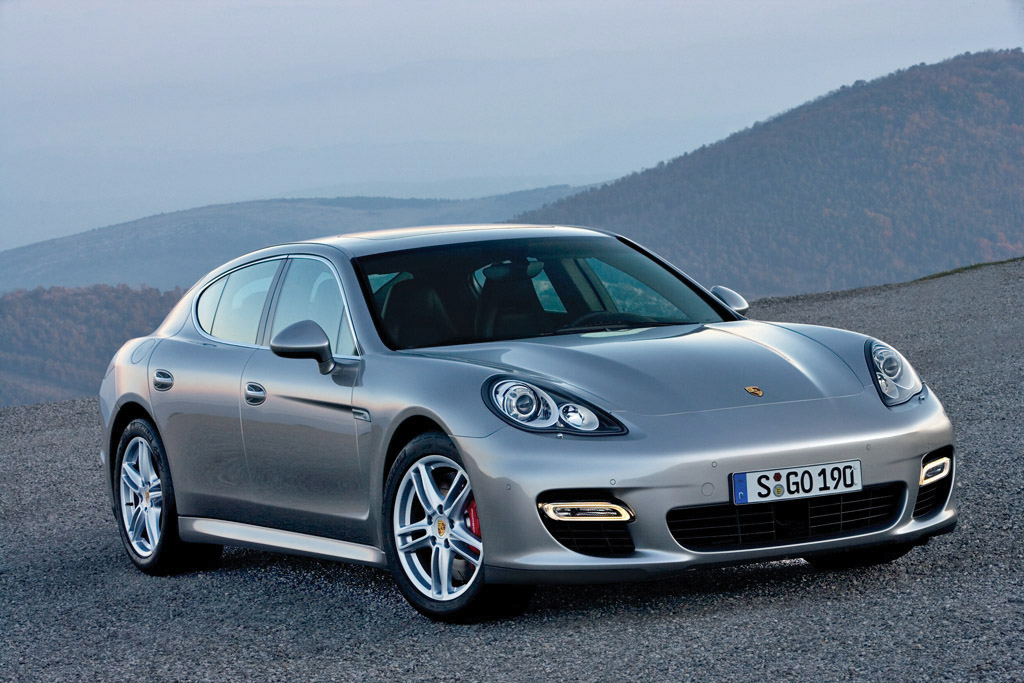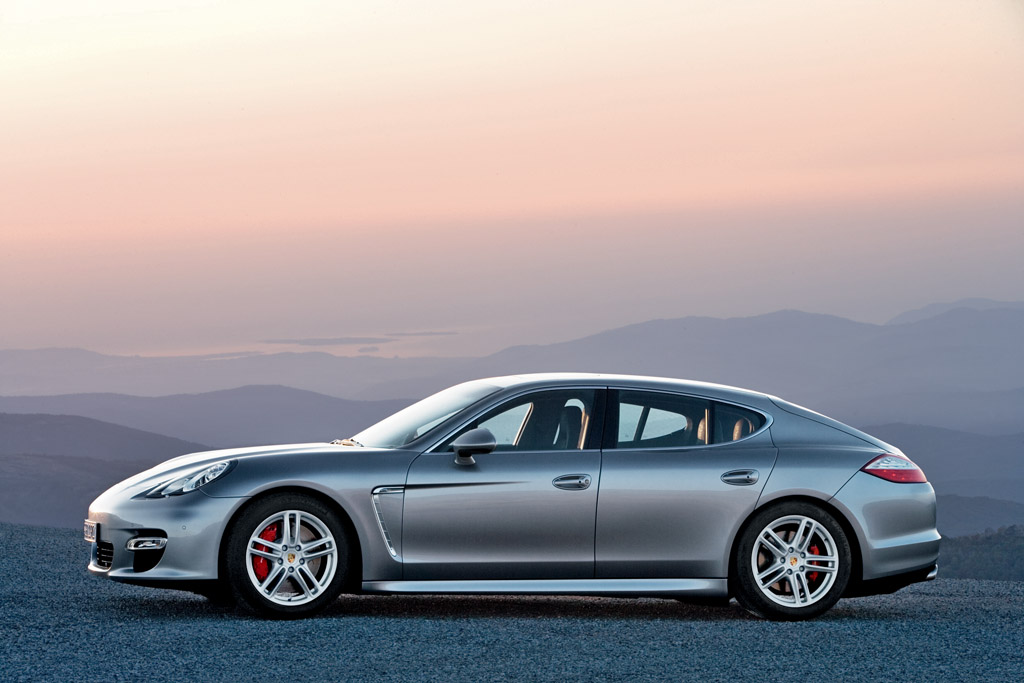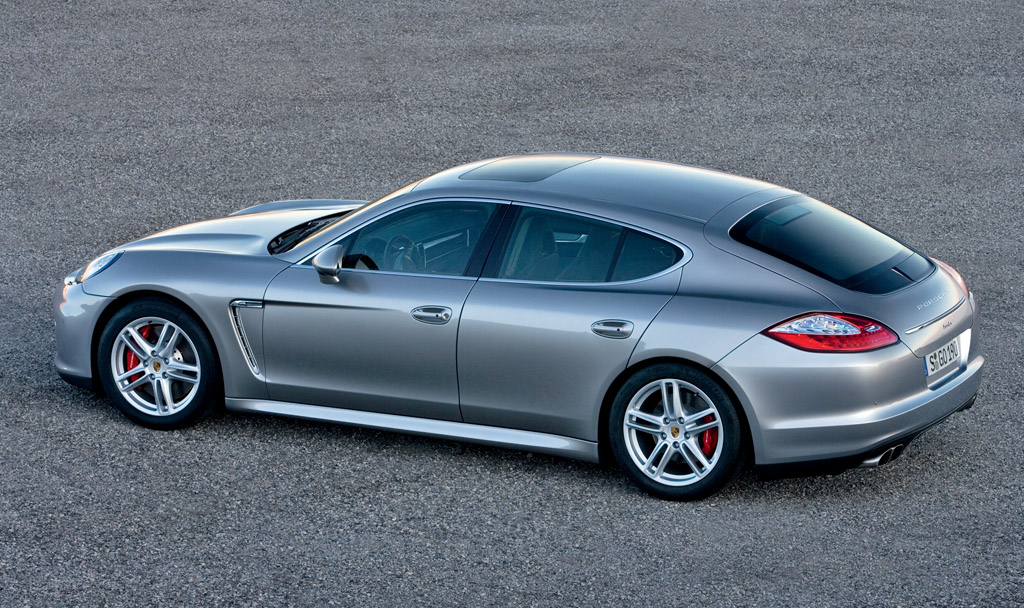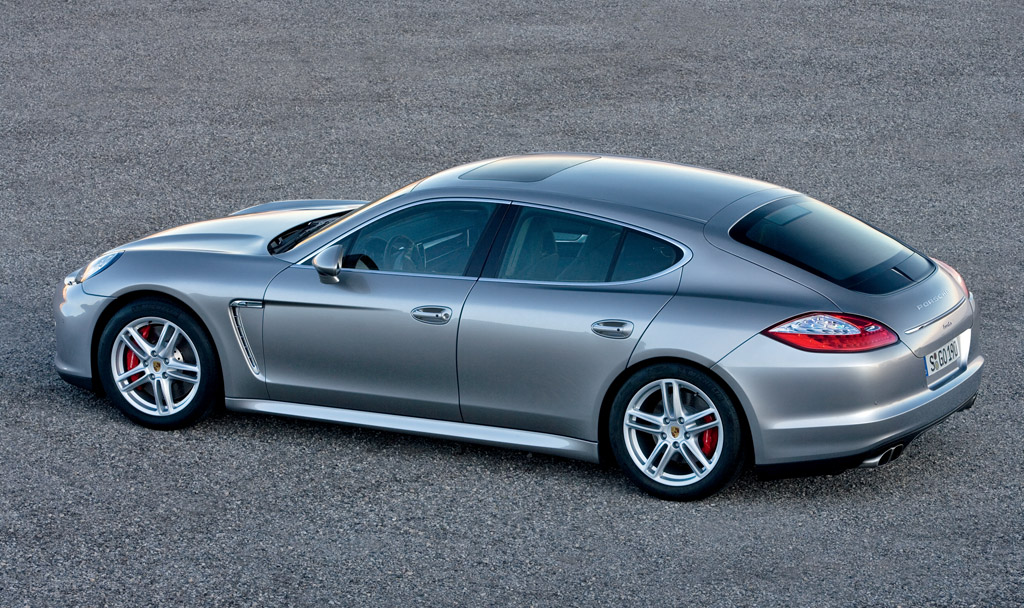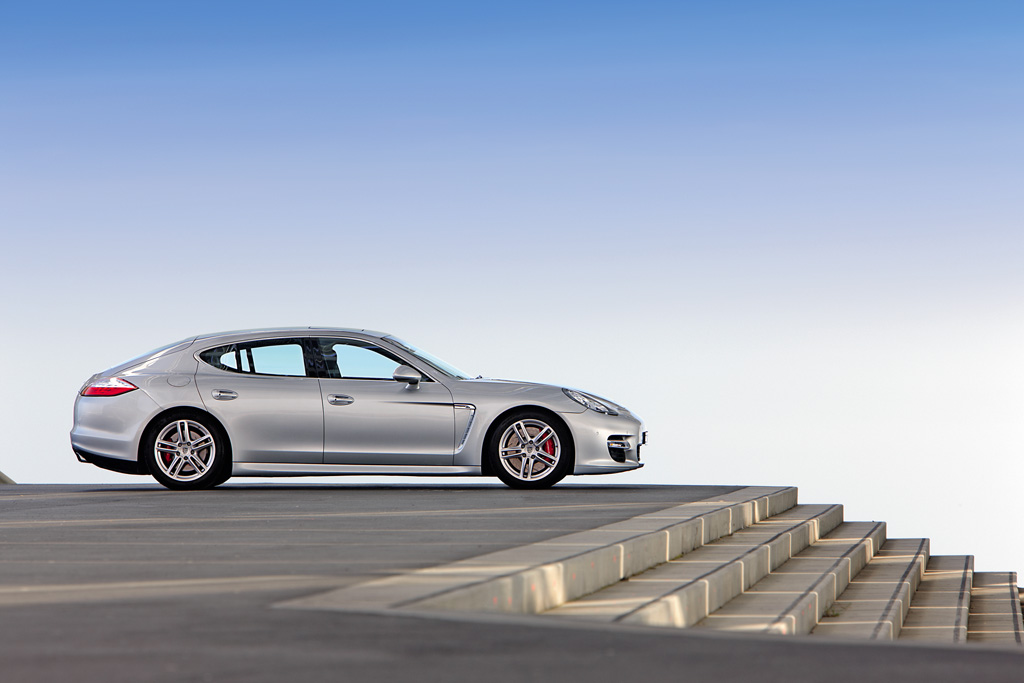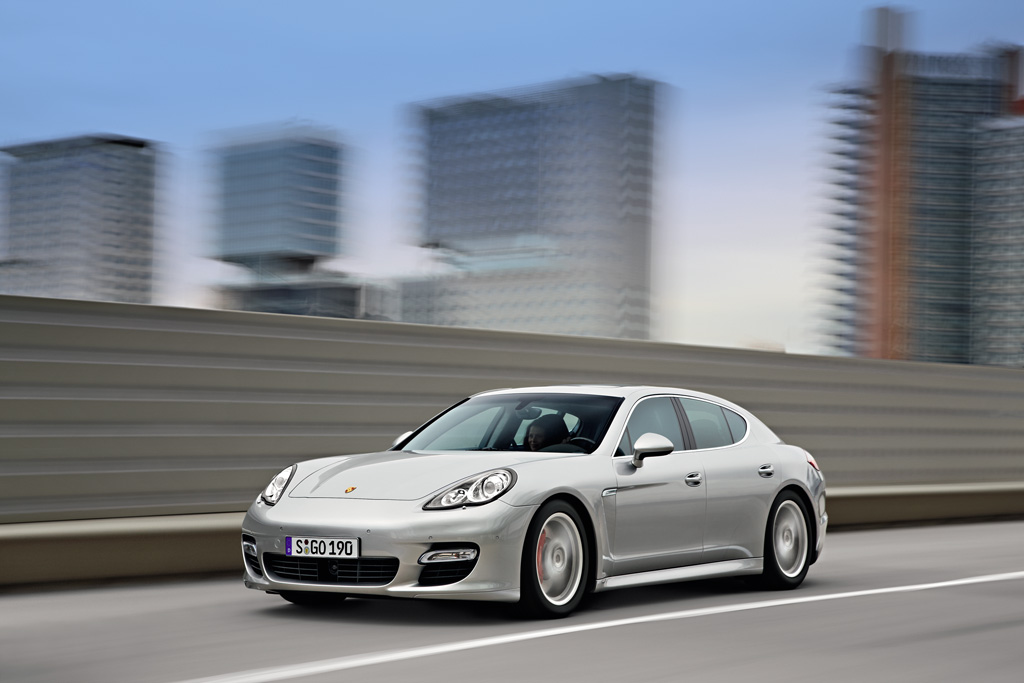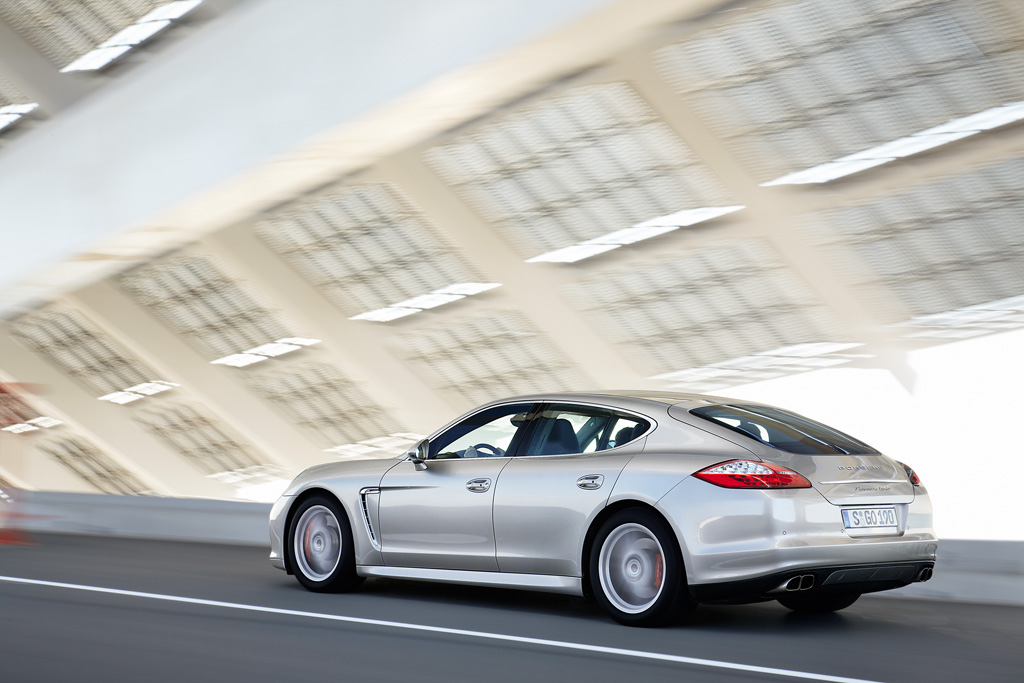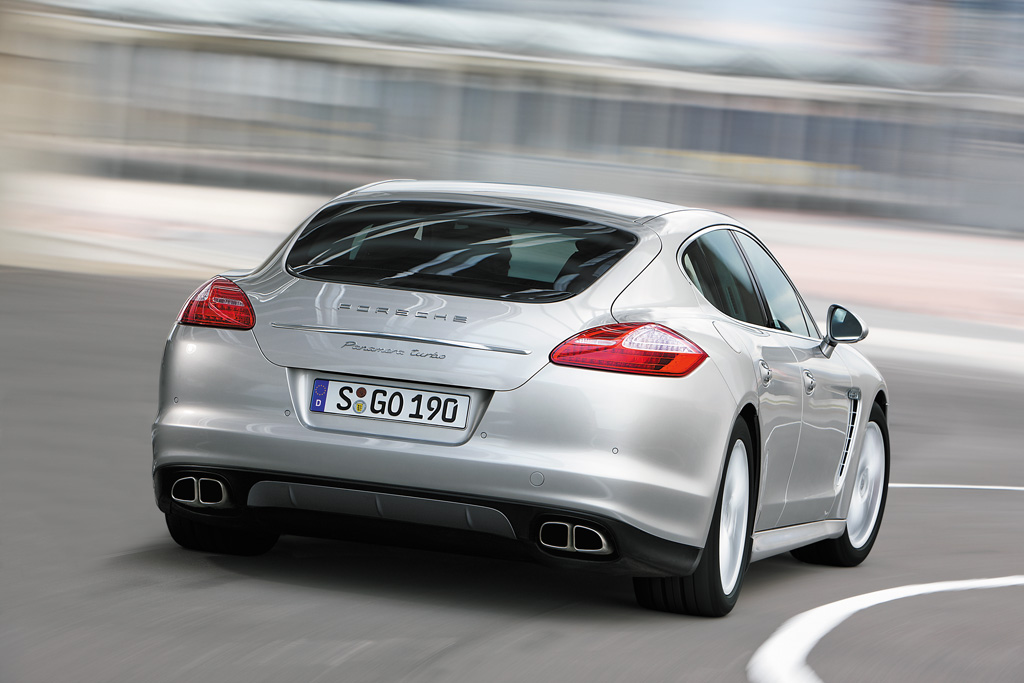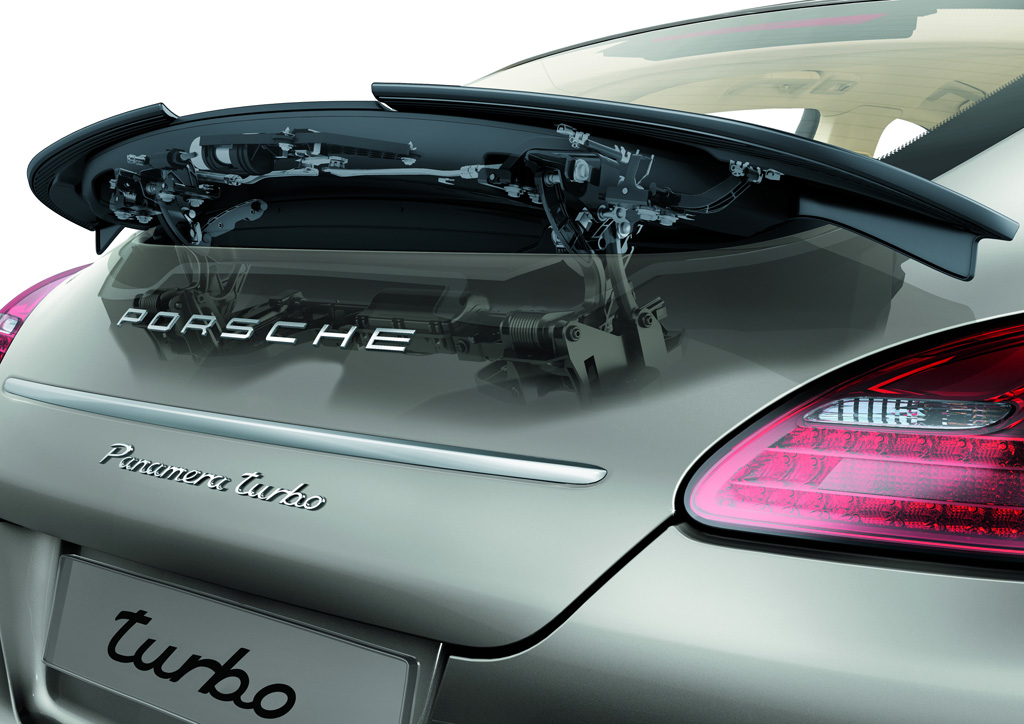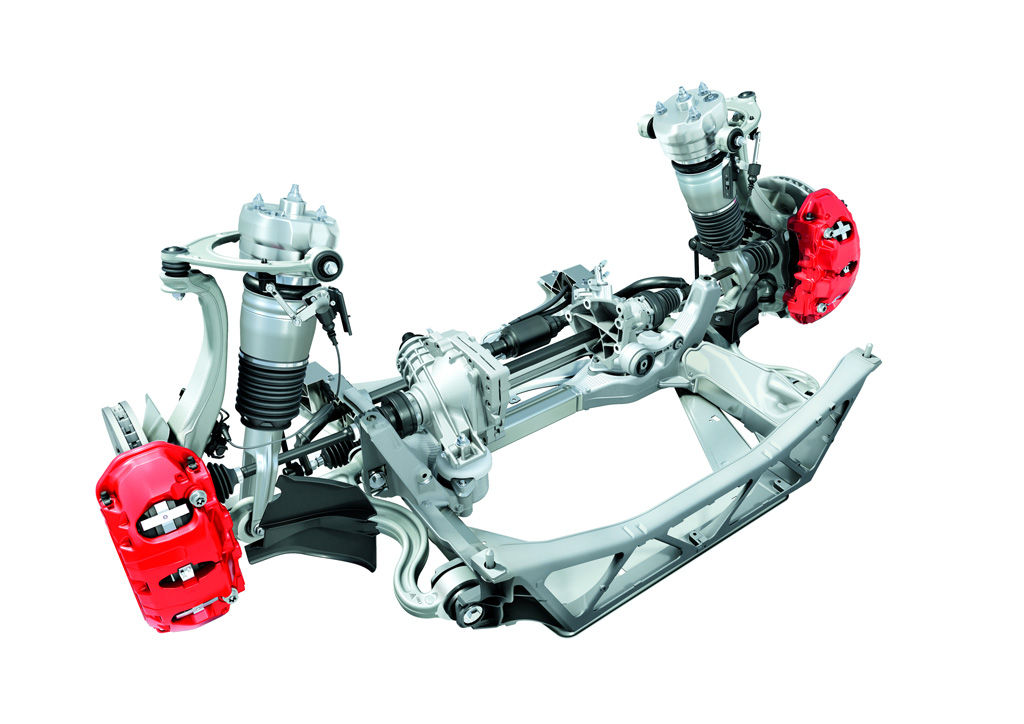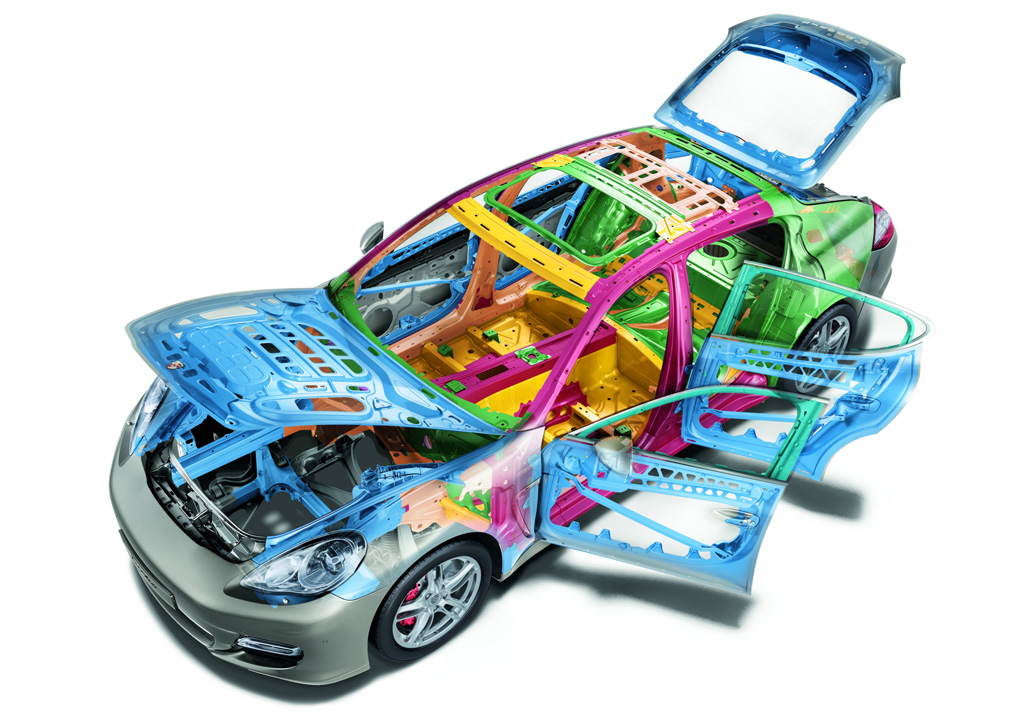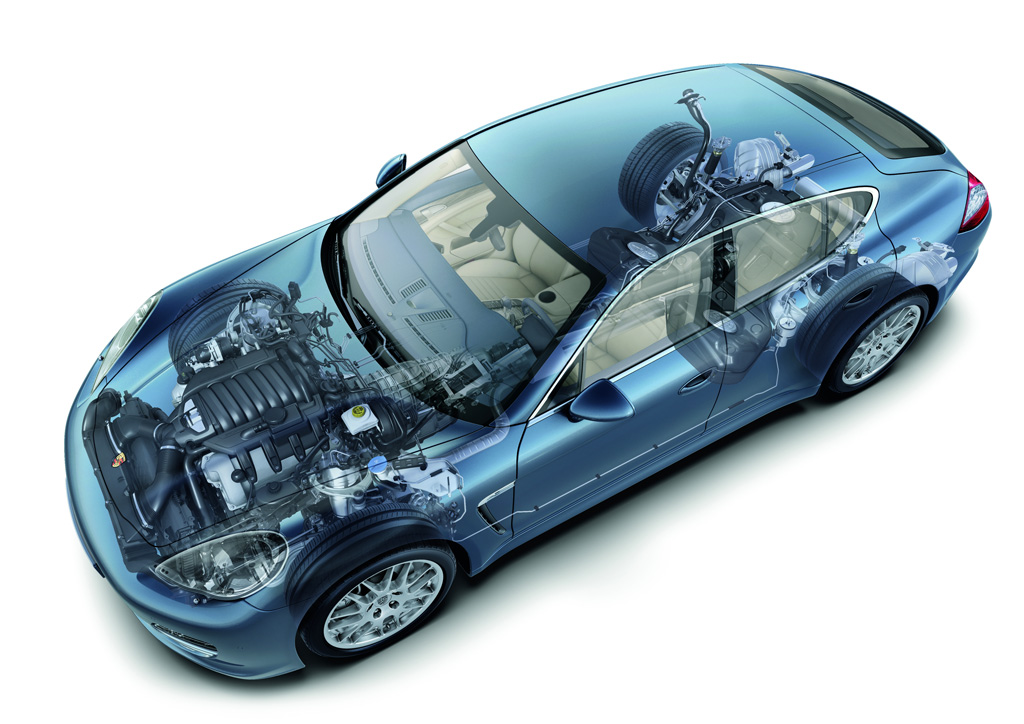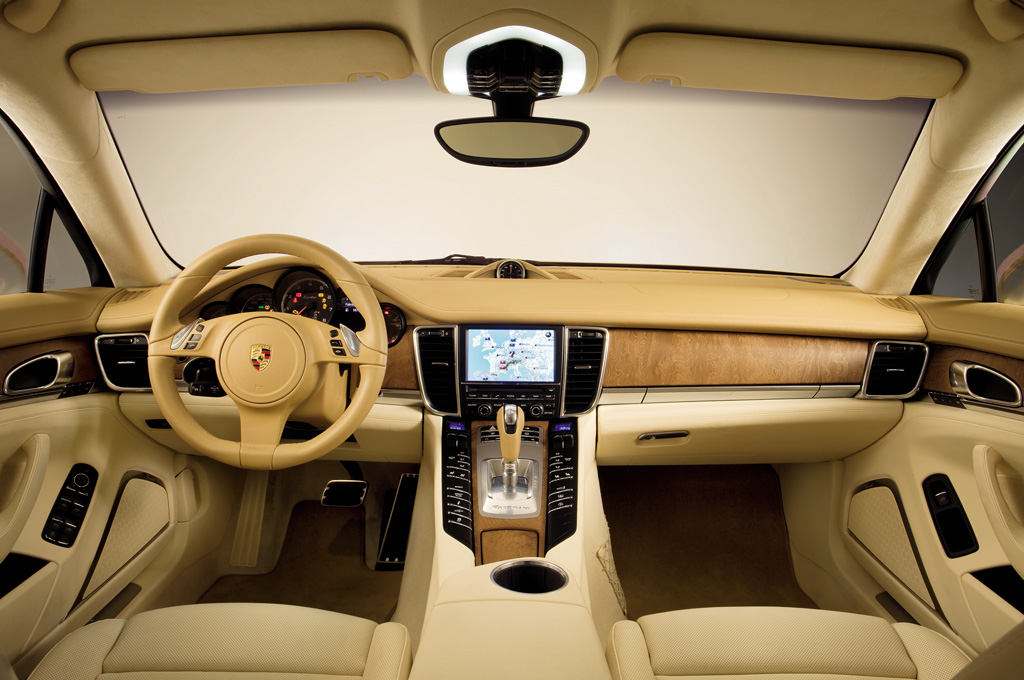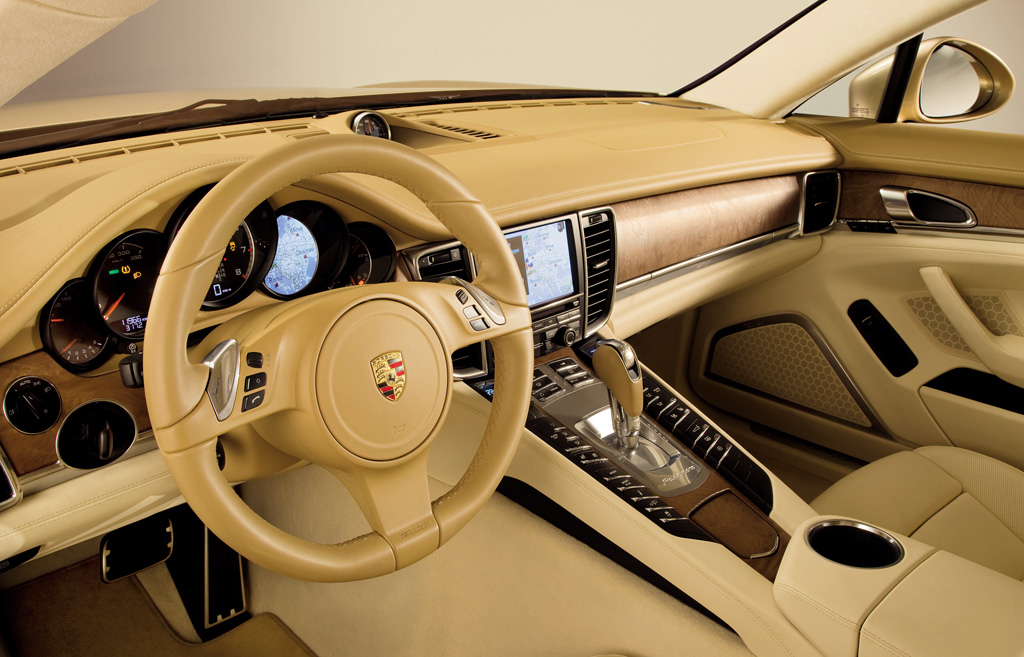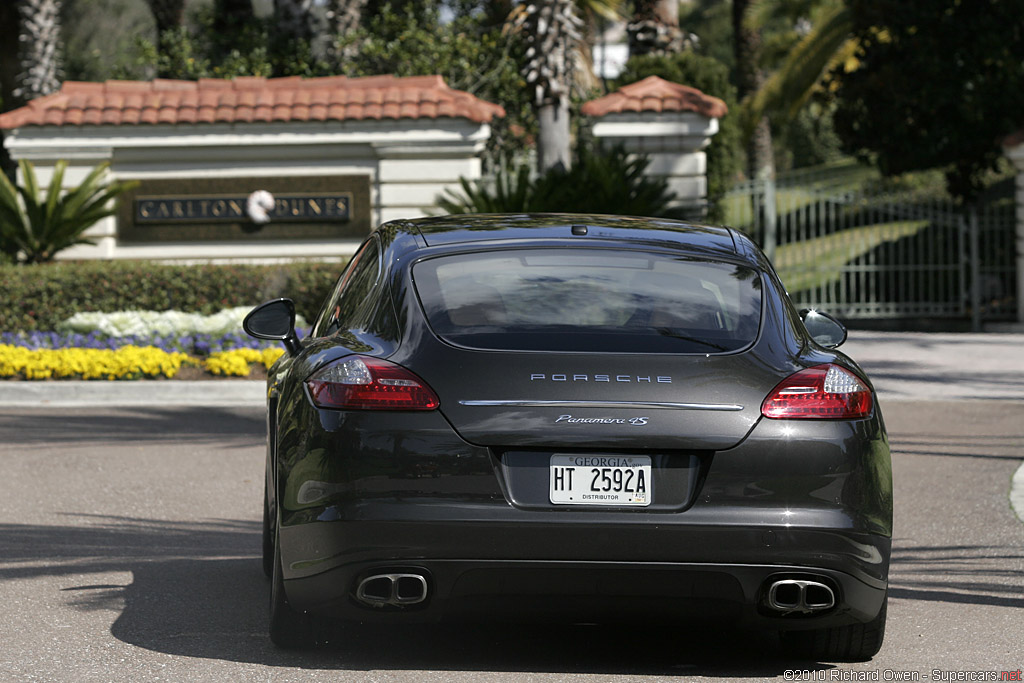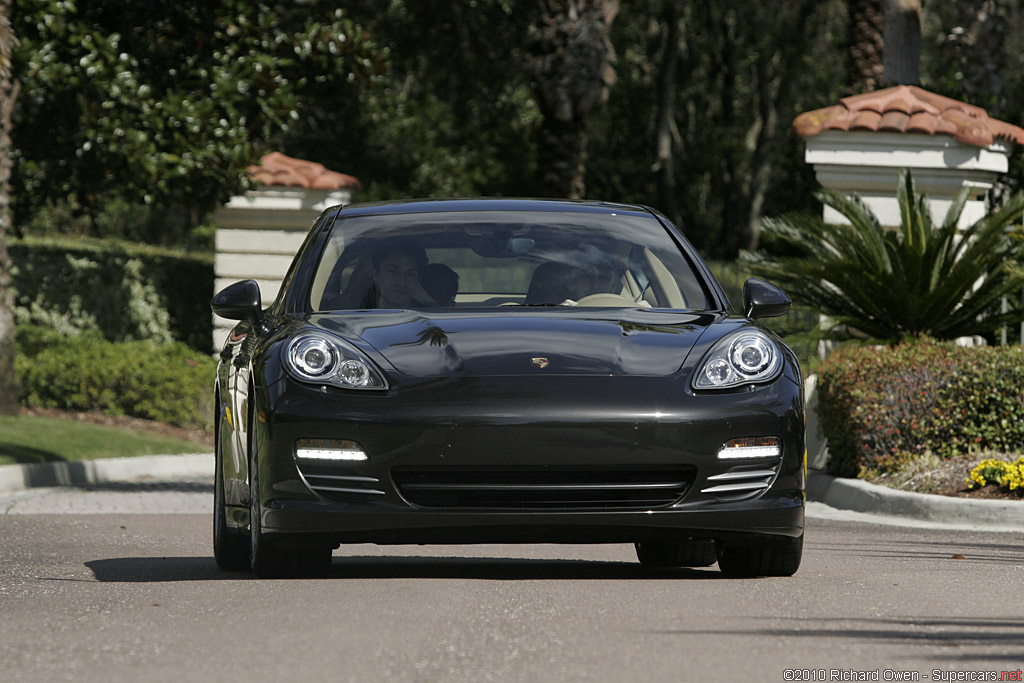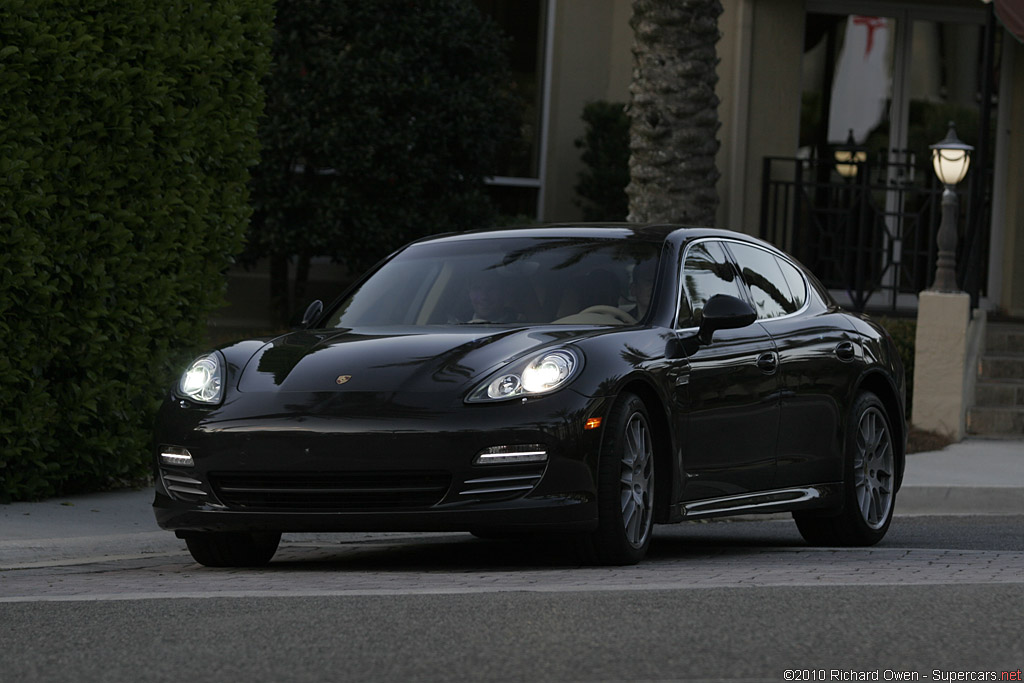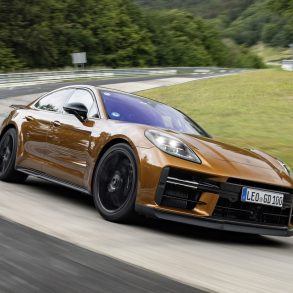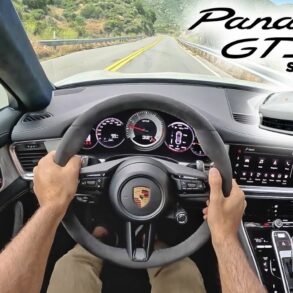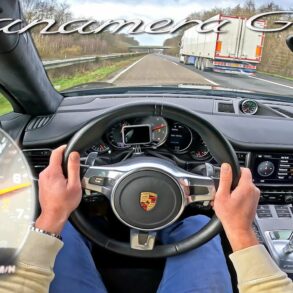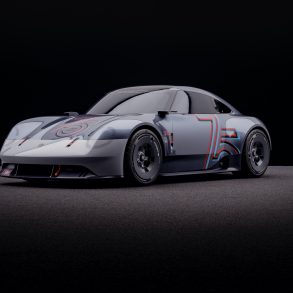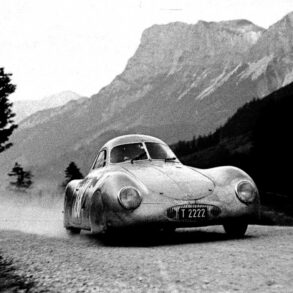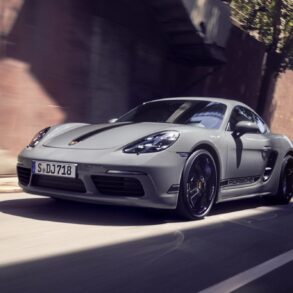(2009 – 2013) Porsche Panamera Turbo – Ultimate Guide
As a top of the range version, the Panamera Turbo featured the same 4.8-liter V8 engine from the S-version, but with a pair of turbochargers that increased the power from 400 hp to 500 hp. It was available exclusively with a 7-speed automatic (PDK double-clutch) gearbox and all-wheel-drive.
Inside, the Panamera Turbo designers took their inspiration from the Vertu luxury mobile phones. A four-seat layout was the only option, with a big center console that separated the driver from the other passengers. In the back, there was a decent room for adults and since it was a hatchback it could get an impressive amount of luggage. The dashboard was typical for a Porsche, with round dials and centrally-mounted tachometer. Despite its hatchback shape, the rear passengers had enough legroom and headroom.
The general public had to wait until the 2009 Shanghai Auto Show to see the new model. The car-maker didn’t start with the entire range. It showed only the S, the S4, and the Turbo versions. While the world was recovering from the financial crisis, the new car emerged as a great value for the new managers and former Porsche 911 drivers.
The Panamera’s headlights resembled those installed on the Cayenne. The profile resembled an elongated 911 or the 989 concept-car. On the front fenders, two vents were used to extract the air within the wheel-well and decrease the front-lift effect. In the back, the taillights resembled those found in the Cayman. In the back, on the trunk-lid, a retractable wing was installed. It was automatically extended at speeds over 120 kph (74.5 mph).
Press Release
Introducing the Panamera, Porsche is proudly presenting the first four-door Gran Turismo in the history of the Company. A brand-new development from the ground up, the Porsche Panamera sets a new benchmark in its class not only through supreme performance combined with exemplary fuel economy, but also through particularly generous comfort on all four seats and a wide range of exclusive features and equipment.
The Porsche Panamera boasts no less than five innovations in technology featured for the first time in a production model in the luxury performance segment: To be specific, Porsche’s Gran Turismo is introducing the first double-clutch gearbox in this segment of the market, the first start-stop system in conjunction with automatic transmission, the first adaptive air suspension with on-demand additional volume in each spring, active aerodynamics provided for the first time by a rear spoiler moving up automatically and adjusting in its air flow angle, and the first Sport Chrono Package serving at a touch of a button to give the engine, the suspension and transmission, together with other components, an even more sporting and more dynamic set-up. And in conjunction with PDK, Launch Control ensures the fastest con ceivable acceleration from a standstill.
The various models in the Porsche Panamera range set a new standard in the luxury performance segment also in terms of efficiency. All models come with Direct Fuel Injection, low-friction drive systems and lightweight bodies. Even the top version, the Porsche Panamera Turbo, weighs less than 2,000 kilos or 4,410 lb (DIN norm) despite its wide range of standard features included from the start.
To reduce fuel consumption and CO2 emissions to an even lower level, all versions of the Panamera with Porsche-Doppelkupplungsgetriebe come with the new Auto Start-Stop function automatically switching off the engine when the car comes to a standstill – for example at the traffic lights or in a traffic jam with the driver holding down the brake pedal – then automatically starting the engine again as soon as the driver lets go of the brake. The result, particularly in city traffic, is a further significant reduction in fuel consumption.
Different suspension set-ups: synthesis of sporting performance and superior comfort
More than any other car in its class, the Porsche Panamera offers a unique combination of sporting performance and superior comfort. Apart from the “regular” steel suspension, the Panamera S and 4S are available as an option with Porsche’s brand-new, adaptive air suspension pro viding additional air volume on each spring – a high-tech system naturally featured as standard on the Panamera Turbo. And both of these suspension systems are combined with PASM Porsche Active Suspension Management for the variation of damper forces.
Adaptive air suspension provides an even wider range of suspension characteristics with further enhanced driving comfort on the one hand and most sporting driving dynamics on the other.
As an option the Porsche Panamera may also be fitted with PDCC Porsche Dynamic Chassis Control actively compensating body roll in bends and at the same time improving the car’s smoothness and behaviour when driving straight-ahead on bumpy roads.
PDCC ensures supreme agility at all speeds, together with optimum steering behaviour and a smooth balance under load change. In conjunction with the electronically controlled rear axle differential for even greater traction and enhanced agility, PDCC thus provides an even higher standard not only of driving dynamics, but also of motoring comfort.
Innovative interior concept: a cockpit for four
Developed consistently as a genuine four-seater, Porsche’s Gran Turismo offers each occupant new benefits and amenities also in terms of interior design and supreme comfort tailored to the driver and his passengers. Despite its unmistakably low, sleek and stretched silhouette, the Porsche Panamera, measuring 4.97 metres or 195.7″ in length, is only 1.42 metres or 55.9″ high, while offering a generous feeling of space on all four seats.
The centre console stretching out all the way from front to rear and rising up towards the instrument panel provides optimum ergonomics for the driver and highlights the personal cocoon so enjoyable for each individual passenger.
The passengers at the rear also enjoy free, unrestricted visibility to the front, with the complete interior of the car offering a unique feeling of transparency and giving the rear-seat passengers the feeling of participating directly in the driving experience – quite literally a cockpit for four.
Breezing through the Wind
Through its design language alone, the Porsche Panamera defines a new segment in the market: With its synthesis of thoroughbred DNA so typical of a sports car but derived from a coupé body, a unique interpretation of classic saloon design, and the advantages of a variable space concept, Porsche’s latest model boasts a truly unmistakable appearance. In its exterior design, the Panamera takes up numerous classic Porsche themes, offering a both dynamic and powerful look despite the very generous space and grace of the interior. And with its compact overall length and short overhangs, relatively low body height but wide and muscular flanks, the Panamera clearly speaks out that classic design language so typical of a Porsche.
Seen from the front, the Porsche Panamera is clearly recognisable as a genuine Porsche bearing strong resemblance to the Company’s sports cars. With the straight upper end above the large air intakes and the powerfully curved front wings encompassing the headlights in their characte ristic shape, the Panamera again cites elements and design features very well known with Porsche.
The horizontally arranged rear light clusters in the outer air intakes and the contoured engine compartment lid, in turn, ensure a truly powerful and muscular look at very first sight.
On the Porsche Panamera S and 4S the front sections and panels are finished in body colour and come complete with integrated openings for cooling air. While the Panamera S is characterised by black double bars in the side air intakes at the front, the all-wheel-drive Panamera 4S stands out clearly through its double bars in titanium colour. Horizontal positioning lights shaped as light conductors between the direction indicators and the daytime driving lights, in turn, give the Panamera its very special characteristic look also at night.
The Porsche Panamera Turbo features a completely different and quite unique front end. The air intakes at the front in the special looks of a Porsche Turbo boast a very special grid structure giving the top-of-the-range model an even more powerful and dynamic look on the road.
The daytime driving lights in the Panamera Turbo are formed by four unique LEDs spaced out around the two round headlights, again giving the car a particularly outstanding, dynamic and sophisticated appearance. The positioning lights, finally, are formed by light conductors around the direction indicators in the front lights to give the Panamera Turbo an absolutely unique look also in the dark.
Seen from the side, the Porsche Panamera again stands out immediately as a genuine Porsche in its own right. The silhouette of the car is characterised by the compact front overhang made even shorter and more compact in its look by the sweeping contours moving down to the inside. The design feature absolutely crucial to that unique look so typical of Porsche, however, is the roofline with its special contour sweeping down softly to the rear into the tail section without a counter-swing in the opposite direction.
Together with the passenger compartment tapering out to the rear, this creates that special combination of lines at the rear end of the car so characteristic of Porsche, flowing in a wide, muscular and contoured sweep into the harmoniously rounded rear end.
The side air outlets in the wings behind the front wheels come in black on the Panamera S and 4S, while on the Panamera Turbo the air outlets and the side fins are finished in chrome look.
Comparatively compact overall length of less than five metres contributes to the extremely dynamic appearance of the car, while small roof spoilers front and rear and the large underfloor cover serve to optimise the aerodynamic qualities of the Porsche Panamera.
Large wheels in exclusive Panamera design
The large wheels with their sporting rim design speak a clear language, giving the Porsche Panamera a powerful and superior stance on the road. The open design of the rims provides a clear and unobstructed view of the extra-large brake system with brake callipers finished in silver on the Panamera S and the Panamera 4S and in red on the Panamera Turbo.
Seen from the rear, the Panamera again stands out immediately as a genuine Porsche. This is ensured, first, by the rear lights in LED technology so typical of Porsche, with the individual light chambers taking up the side-line of the car and the horizontal graphics of the lights emphasising the sheer width of the Panamera at night. The second highlight is provided by the dual tailpipes finished in brushed stainless steel left and right which, through their dynamic look, add to the unique style of power and performance offered by the Panamera at very first sight. On the Panamera S and the Panamera 4S the dual tailpipes are round, on the Panamera Turbo they are square in design.
Yet another optical highlight is the diffuser integrated in the rear end of the car as part of its sophisticated aerodynamic concept. On the Porsche Panamera S the diffuser is smooth and black, on the Panamera 4S it is also black in colour but comes with additional ribs down the side, and on the Panamera Turbo the diffuser features both vertical ribs and a special titanium colour.
Variable spoilers: aerodynamics comparable to the 911 Carrera
A key element contributing significantly to the outstanding efficiency of the Porsche Panamera is the car’s outstanding aerodynamics: like the 911 Carrera sports cars, Porsche’s Gran Turismo comes with a drag coefficient of just 0.29 (Panamera S/4S) and, respectively, 0.30 (Panamera Turbo). This supreme streamlining serves, first, to enhance driving performance to an even higher standard and, second, to minimise fuel consumption as another significant economy factor.
A particular highlight is the adaptive spoiler at the lower end of the rear window moving up at a speed of 90 km/h or 56 mph and automatically adjusting to the optimum angle as a function of current road speed. While the Porsche Panamera S and 4S come with a so-called two-way spoiler, the Panamera Turbo boasts an even more sophisticated four-way spoiler, a worldwide innovation in the luxury class, with the two-piece upper section moving out in width while moving up in order to make the spoiler even larger and more efficient for a further improvement of the car’s aerodynamics. And like on the Carrera models, the spoiler may also be moved out manually.
In both cases the spoiler moves up to an angle of -3° off the horizontal plane starting at a speed of 90 km/h or 56 mph, reducing air resistance to an even lower level. Starting at 160 km/h or approximately 100 mph, the two-way spoiler on the Panamera S and 4S is set to 5°, then moving to the performance setting with an angle of 14° as of a speed of 205 km/h or 127 mph.
The four-way spoiler on the Panamera Turbo, in turn, remains in the -3° position up to 205 km/h and then moves directly to the performance position of 10° on the Turbo. As a result, this special version of the rear spoiler not only reduces lift forces, but even produces downforce on the rear axle at high speeds, like the rear wing on the 911 Turbo. Clearly, this gives the Porsche Panamera excellent roadholding and supreme directional and tracking stability also at very high speeds.
Precise calculation of air flow
At the front the Panamera is characterised in its looks by the specially designed front sec tion with three large air intakes. On the Panamera S and the Panamera 4S the side air intakes are closed in the interest of enhanced aerodynamics and an even better drag coefficient, with the normal aspiration engine drawing in air from beneath the car.
On the Porsche Panamera Turbo the intercoolers are directly behind the side air intakes left open on this model and thus feeding in an ample supply of air, with additional cooling air coming from the air scoop in the middle with its bypass ducts.
The sensor on the optional cruise control with its distance control function has also been optimised appropriately – positioned in the centre air intake, the sensor does not influence the supply of cooling air in any respect.
Ducts beneath the spoiler lips on the outside of the front air dam provide a steady supply of air to the brakes for cooling purposes, with air flowing directly to the inside of the wheels. Thanks to their intelligent configuration, these ducts also serve to reduce lift forces at the front, brake air guide blades on the Panamera Turbo cooling the brake system with even greater efficiency and an enhanced effect.
Seen from the side, the Panamera boasts that typical flyline impressively reflecting the aerodynamic qualities of the car. The air outlets behind the front wheels, the exterior mirrors, and the rear spoiler moving up as a function of speed are particularly conspicuous highlights. Special wheel spoilers, in turn, serve to optimise the flow of air around the wheels, while the side windows absolutely flush with the A-, B- and C-pillars ensure a smooth flow of air around the car.
The exterior mirrors are specially designed for minimum air resistance and are fitted on the doors and not, as is usually the case, on the mirror quarterlights in order to improve not only the car’s aerodynamics and acoustics, but also visibility to the rear, avoiding the build-up of dirt on the side windows.
All models in the Porsche Panamera range come with an underfloor cover extending almost comple tely from front to rear and side to side in order to optimise the flow of air beneath the car and reduce air swirl or turbulence. The Panamera is indeed the first car in this segment with an underfloor cover also around the driveshaft tunnel and the rear mufflers, helping to reduce air resistance and lift forces on the axles for better streamlining and enhanced fuel economy.
Providing such full coverage, the underfloor of the car guides the air flowing by to exactly the right points where specific components on the Panamera require extra cooling. Intake gills around the rear axle differential, for example, draw in cooling air to keep the differential appropriately cool and efficient at all times. The rear diffuser, in turn, together with the rear spoiler, serves to further reduce lift forces at the rear of the car.
Superior Eight-Cylinder Developing 400 and 500 bhp
The Porsche Panamera is entering the market exclusively with 4.8-litre eight-cylinder power units in two output stages, giving Porsche’s supreme Gran Turismo excellent performance under all conditions.
Based on the V8 power units already featured in the Cayenne, the new engine have been thoroughly upgraded and modified for the Panamera, one feature being the re-designed, flatter oil sumps helping to lower the car’s centre of gravity.
A further new feature on the all-wheel drive Panamera 4S and Panamera Turbo is the final drive on the front axle connected directly to the engine.
A wide range of other improvements and detailed refinements serves furthermore to improve the output and all-round economy of the engines to an even higher standard, naturally starting from optimum engine qualities to begin with.
The Panamera S and Panamera 4S both come with a new generation of Porsche’s 4.8-litre naturally-aspirated V8, the modified intake system, together with optimised engine management, increasing engine output to 400 bhp (294 kW) at 6,500 rpm and raising engine torque to 500 Nm (369 lb-ft) between 3,500 and 5,000 rpm.
In thePorsche Panamera Turbo the 4.8-litre V8 biturbo delivers maximum output of 500 bhp (368 kW) at 6,000 rpm and peak torque of 700 Nm (516 lb-ft) all the way from a low 2,250 rpm to a midrange 4,500 rpm.
All models come with Porsche DFI Direct Fuel Injection and VarioCam Plus one-sided variable camshaft management with adjustable valve lift.
Upgraded normal-aspiration power units even lighter than before
One of the main objectives in upgrading the engines was to reduce all moving and nonmoving masses to an even lower level than before. Hence, all the engines now come with
- a valve control box and valve cover made of magnesium (weight-saving: 2.5 kg),
- lightweight camshaft adjusters made of aluminium throughout (weight-saving: 1.7 kg),
- aluminium bolts on all magnesium components and for connecting the engine and transmission (weight-saving: 1 kg), as well as
- an intake manifold with extra-thin walls (weight-saving: 1.2 kg).
Working on the naturally-aspirated power unit of the Panamera S and the Panamera 4S, Porsche’s engineers have developed a new, even lighter crankshaft and lighter connecting rods. All together, the reduction in weight provided in this way on the crankdrive alone is 2.3 kg or more than 5.0 lb compared with the engine in the Cayenne S.
The reduction of weight precisely at this point pays off in two respects, lower rotating masses giving the engine an even more spontaneous response and making it even more fuel-effi cient and smoother.
The engine in the Panamera S comes with a magnesium oil flow housing serving to reduce weight even further by approximately two kilos, while the housing on the Panamera 4S is made of aluminium, as before, on account of the fully integrated front wheel final drive.
The variable intake manifold is designed to provide a muscular torque curve with even better flow and lower resistance than on the Cayenne S. This extra smoothness is ensured, first, by the even larger throttle butterfly and, second, by the new pressure sensor serving to measure air mass flow. Featured for the first time in a production Porsche, this new sensor takes the place of the former hot film sensor which, unlike the pressure sensor, has to be positioned in the flow of air coming in and therefore acts as a throttle. The result is 15 bhp or almost 4 per cent more power than on the Cayenne S.
Like the power unit in the Cayenne S, the naturally-aspirated engine on the Panamera comes with a switching intake manifold combining the benefits of a long intake manifold – higher torque at lower engine speeds – with the advantages of a short manifold – high specific output at high engine speeds.
As a function of engine speed, the resonance intake system uses air oscillation in the intake manifold to give the engine an even better fuel/air charge for extra power and efficiency. And being made of a special synthetic material, the multi-piece intake system is particularly light, again helping to reduce weight to a minimum.
Driving dynamics optimised by the low-fitted engine
With driving dynamics being a particular highlight of the Porsche Panamera, the power unit in Porsche’s new Gran Turismo comes in an unusually low position within the car. Clearly, this has a direct effect on the centre of gravity and, accordingly, ensures driving dynamics typical of Porsche with truly outstanding road performance and driving stability at all times.
To provide this new configuration, all engines in the Panamera come with a new, extremely low oil sump. On the models equipped with PTM Porsche Traction Management the front axle differential is connected directly to the engine in order to keep the centre of gravity extra-low also in this case. So instead of fitting the engine higher up and positioning the drive shaft beneath the engine, the driveshaft runs directly through the crankcase in a channel at the front.
Operating on-demand, the oil pump likewise comes in new, extra-low design with very compact gearsets. Through hydraulic adjustment of the gear width in mesh controlled by oil pressure, the amount of oil delivered by the pump may be varied individually as required, thus reducing the consumption of energy to a minimum while ensuring appropriate lubri cation tailored to engine load and running conditions at all times.
To ensure a smooth and reliable supply of oil under all conditions, the V8 power units fea ture integrated dry sump lubrication.
Turbo engine with upgraded turbocharger modules
Seeking to keep the centre of gravity as low as possible, Porsche’s engineers have also modified the eight-cylinder turbo engine for the Panamera, working above all on the two turbochargers positioned parallel to one another. For the first time the power unit in the Panamera Turbo comes with a single-piece exhaust manifold turbocharger module made of a hightemperature- resistant steel casting without a connection flange in between and therefore ensuring particularly compact dimensions. A further advantage of this configuration is the optimised cross-sections providing even better flow conditions and therefore minimising the loss of pressure upstream of the turbine.
Through a separate intercooler on each row of cylinders, the enhanced cooling effect serves, first, to maximise the cylinder charge and, second, to reduce the temperature of the various components.
While the intake system in the Porsche Panamera Turbo is largely the same as in the naturally-aspirated V8, the turbocharged engine, unlike the naturally-aspirated power unit, does not require switching flaps since the charge effect is ensured by the two turbochargers, the full effect of the short intake manifolds thus being maintained throughout the entire engine speed and performance range.
Again to reduce weight, the power unit in the Panamera Turbo likewise comes with an extralight crankshaft 0.6 kilos lighter than before. And like on the naturally-aspirated engine, the counterweights on the crankshaft cover a bigger radius than on the former model.
Featured as standard: Sports Button for an even more thrilling driving experience
The Sports Button positioned in the middle on the centre console on the side of the gearshift or, respectively, PDK selector lever facing the driver is a standard feature on all models in the Panamera range. This allows the driver to choose either a more comfort- and economyoriented style of motoring or, whenever he wishes, a more sporting and dynamic style. And whenever he presses the Sports Button, the word “Sport” lights up in the instrument cluster.
In the Sports Mode the electronic engine management gives the engine an even more aggressive and spontaneous touch. On models featuring the Porsche-Doppelkupplungsgetriebe the gears shift up later and shift down earlier in the Automatic Mode. A further point is that the Auto Start-Stop function is deactivated, with both PASM Porsche Active Suspension Management and optional PDCC Porsche Dynamic Chassis Control automatically switching to the Sports Mode as well to give the car an even more sporting set-up and provide even more direct steering behaviour in bends.
In the Panamera 4S and the Panamera Turbo, finally, the active PTM all-wheel drive feeds more power and torque to the rear wheels, again in the interest of enhanced and even more dynamic performance.
Sports Chrono Packages for the truly ambitious driver
Like Porsche’s sports cars, the Panamera is available with Sports Chrono Packages in combination with PCM Porsche Communication Management for the particularly sporting and ambitious driver. In this case the new Gran Turismo comes with another button on the centre console bearing the name “Sport Plus” for even more dynamic driving performance than with the Sports Button featured as standard:
- On the Panamera Turbo the Sport Plus Mode activates the Overboost function, briefly increasing turbocharger pressure whenever the driver kicks down the gas pedal or moves it particularly quickly. This increase in turbocharger pressure raises maximum torque to a significantly higher level up by 10 per cent. So peak torque between 3,000 and 4,000 rpm is 770 Nm (567 lb-ft) instead of the usual 700 Nm (516 lb-ft).
- The transition between driving under power and driving in overrun (and vice versa) becomes even more sporting and dynamic, with a more spontaneous and dynamic load change.
- On models featuring PDK double-clutch transmission gearshift times are even shorter and the entire shift process even more dynamic. When slowing down only slightly, the Automatic Mode shifts down even more dynamically to a lower gear, also at high engine speeds. The gearshift points, in turn, are moved up to higher engine speeds, gears shifting up later when accelerating and shifting down earlier when reducing speed. And when shifting gears manually, the gearshift process is likewise faster, more dynamic and athletic.
- PASM Porsche Active Suspension Management featured as standard gives the car an even more sporting set-up with a more direct steering response and even better roadholding.
- Adaptive air suspension lowers the entire car by 25 millimetres or almost one inch to the low level and switches over to a harder spring rate.
- PDCC Stability Control eliminates body roll almost completely in bends.
- PSM Porsche Stability Management intervenes later in the interest of enhanced straightahead and lateral dynamics, giving the car significantly greater agility when braking into a bend. Particularly at low speeds, PSM allows an even more sporting style of driving when applying the brakes and accelerating out of a bend, thus ensuring an even higher standard of driving pleasure. And with PSM switched off, the Sport Plus Mode offers even greater agility while nevertheless retaining the PSM function as a safety factor in the background, PSM automatically switching on again as soon as both front wheels reach the ABS control point.
- Last but not least, the angle of the rear spoiler changes to the performance setting regardless of the road speed of the car.
Once the driver has activated the Sports Button he may manually choose another suspension program in all cases, unless he is in the PSM mode. And once the driver switches off the engine, deactivating the ignition, the Sports Mode is also deactivated and all settings return to the Normal Mode.
A particular highlight of the Sports Chrono Packages is the stopwatch on the dashboard. To display, save and evaluate lap times as well as the times required on individual routes, PCM Porsche Communication Management is further enhanced by an additional Performance Display presenting the overall time required on a specific route or lap, the distance covered on the last lap, the total number of laps completed so far, and the driver’s individual lap times. The fastest lap and the distance remaining before filling up the tank are also presented in the Display, which likewise allows the driver to record individual distances/routes and define reference routes.
A special feature on the Sports Chrono Package for PDK models is Porsche Launch Control for optimum acceleration from a standstill. To enjoy the extra power and performance of Launch Control, the driver must first press the Sport Plus Button with the driving modes D or M activated. Then he holds down the brake pedal with his left foot and at the same time gives full throttle (kick-down) with his right foot. This raises engine speed to the optimum level on each model variant and the clutch is moved to a pre-engagement position, with the words “Launch Control Active” appearing in the instrument cluster.
Then, as soon as the driver lets go of the brake, the Porsche Panamera will accelerate all-out to achieve the fastest possible sprint 0.2 seconds faster to 100 km/h on all versions of the Panamera with Launch Control.
Fit for Euro 5 and ULEV: stainless-steel exhaust system
The exhaust emissions flow through an exhaust system made of stainless steel with a particularly long service life. To keep emissions to a minimum above all when starting the engine cold, it is essential to quickly raise the temperature of the catalysts to the optimum operating level. On European models this is done by blowing secondary air into the exhaust ducts after starting the engine cold, increasing the temperature of the exhaust emissions accordingly. This quickly heats up the catalytic converters and ensures highly effective emission management. As a result, all versions of the Panamera significantly outperform the Euro 5 standard in Europe and qualify in the USA as Ultra-Low Emission Vehicles (ULEVs; Turbo: Low Emission Vehicle, LEV).
The exhaust system on the Porsche Panamera Turbo comes with an even larger cross-section, exhaust emissions flowing out through two silver-matt dual tailpipes on either side square in shape as opposed to the rounded tailpipes on the Panamera S and 4S. To ensure exactly the right sound effect at all times, exhaust flaps open up either two or all four tailpipes as a function of engine speed.
All models in the Panamera range come as an option with a sports exhaust system available for the first time not only on the models with a naturally-aspirated power unit, but also on the Turbo. In this case the specially engineered main silencer generates a particularly throaty and muscular chortle. Like on the regular exhaust system of the Panamera Turbo, two exhaust flaps between the rear mufflers and the tailpipe covers open up whenever required for an even better flow of exhaust gas.
The sports exhaust system boasts two strikingly designed dual tailpipes with titanium-co loured surrounds further highlighted by dual tailpipe covers made of stainless steel.
To generate the particularly muscular sports car sound, all the driver has to do is press an additional button in the centre console, the sound effect then being varied as a function of load, road speed, engine speed, and the gear in mesh.
World debut in the Porsche Panamera class: Auto Start-Stop in conjunction with PDK
The Porsche Panamera is the first car in the luxury performance class to introduce the Auto Start-Stop function as a world-first achievement. All versions of the new Gran Turismo with the Porsche-Doppelkupplungsgetriebe or double-clutch gearbox come as standard with this fuel-saving system the driver is able to deactivate or activate individually whenever he wishes or in accordance with national requirements by way of a button in the centre console.
Auto Start-Stop is able to save up to 10 per cent fuel in the urban cycle and approximately 5 per cent in the New European Driving Cycle, in the process reducing CO2 emissions by approximately 5 per cent. And not least, deactivation of the engine at a standstill also offers the occupants an even higher level of comfort in the car.
Whenever the driver slows down to a standstill with the Auto Start-Stop function active and with his foot on the brake pedal, Auto Start-Stop will switch off the engine completely after about a second, informing the driver of this function through the green Auto Start-Stop symbol in the instrument cluster.
This will not happen whenever sensors in the car notice that the driver is manoeuvring the car or towing a trailer, whenever driving on steep gradients, in the Sports and Sports Plus Mode, and with PSM deactivated. When coming to a halt on a slight uphill or downhill gradient, PSM will support the driver by maintaining brake pressure in order to prevent the car from rolling back against the direction of travel once the driver has switched off the engine.
The most important comfort and safety functions naturally remain fully operative also when the engine is switched off, all audio and communication systems, lights, airbag systems and PSM remaining fully active. The air conditioning, in turn, keeps the temperature inside the car at a comfortable level by using residual heat from the engine to heat up the interior or residual energy in the cooling system to reduce the interior temperature. And as soon as the interior temperature starts to vary significantly from the pre-selected level, the system will automatically start the engine again.
The engine re-starts automatically when the driver lets go of the brake pedal. To complete this starting process as quickly as possible, with minimum energy and with minimum load on the battery, the engine re-start is supported by Direct Fuel Injection and the ignition. For this purpose the engine is supplemented by an additional sensor recognising the position of the crankshaft and thus indicating which cylinder may be filled and ignited first. This serves to build up sufficient engine power for setting off right away.
For safety reasons the re-starting process remains deactivated as long as the driver’s door is open or he has not fastened his seat belt.
The Auto Start-Stop function comes with a reinforced starter taking the more frequent starting-up process into account. The battery is constantly monitored for its charge level and service status in order to ensure a reliable re-start at all times, since the battery and starter are naturally subject to wear and tear, especially when used frequently to re-start the engine.
Cruise control available as an option with radar-based distance control function
All versions of the Panamera come as standard with automatic cruise control enhancing motoring comfort on long distances by automatically maintaining the cruising speed preselected by the driver in a range from 30 – 240 km/h (19 – 149 mph).
In conjunction with PDK transmission, the Panamera is optionally available with cruise and distance control operating within a range between 30 and 210 km/h (19 and 130 mph). Using a radar sensor, this high-tech unit monitors the distance from the vehicle ahead, automatically maintains an appropriate safety distance and, when necessary, applies the brakes up to a force of 3.5 metres/sec2 until the car comes to a standstill.
To enhance motoring comfort for the driver, this special radar-based cruise control slows down the car to a very low speed (“crawl function”) before coming to a complete stop, thus avoiding the need to stop the car abruptly whenever the vehicle ahead stops only briefly and allowing the driver to continue smoothly at a slow pace for as long as possible.
This crawl function is provided by increasing slip on the PDK wet clutch without, however, increasing wear and tear on the clutch.
Porsche cruise and distance control also offers special functions such as overtaking aid, speed control in bends, and a distance warning function. As soon as the driver sets the di rection indicator when overtaking another vehicle, for example, the overtaking aid will deac tivate the distance control function to the vehicle ahead at an earlier point and automati cally speed up the car, provided the overtaking lane is free.
When taking a bend with the cruise distance control function active but without a vehicle ahead, the system will activate the bend speed control function as of a certain level of lateral acceleration or, at low speeds, as of a certain steering angle. This reduces or completely interrupts the automatic acceleration effect or, respectively, reduces the speed of the car appropriately for a lower level of lateral acceleration. Then, once the car has completed the bend, the acceleration function is re-activated in order to return to the speed originally set.
The distance warning function offers the driver helpful support even when the cruise and distance control is deactivated: Should the driver come too close to a vehicle ahead with the system in standby, he is warned accordingly by a yellow warning triangle flashing on in the instrument cluster. The TFT Display in the instrument cluster, in turn, allows the driver to choose a distance warning display together with a wide range of further information such as the desired and actual distance from the vehicle ahead, his desired speed or the speed of the vehicle in front.
World debut: first Gran Turismo with double-clutch transmission
The Porsche Panamera is the first car worldwide in the luxury performance class to offer a double-clutch transmission – the PDK Porsche-Doppelkupplungsgetriebe standard on the Panamera 4S and the Panamera Turbo and available as an option on the Panamera S.
PDK combines the driving dynamics and very good mechanical efficiency of a manual gearbox with the superior shift and motoring comfort of a conventional automatic transmission, without any noticeable interruption of traction and drive power. It offers both a manual mode including the recommended gear and an automatic mode for superior comfort, thus giving the driver both a sporting as well as a comfort-oriented driving option whenever he wishes.
As on Porsche’s sports cars, the driver operates the new Porsche-Doppelkupplungsgetriebe either through the selector lever in the centre console or by means of two paddles in the spokes of the steering wheel. In the manual shift mode, in turn, the gear recommended in the instrument cluster enables the driver to optimise the fuel efficiency and all-round eco nomy of his car.
Being completely revised, the existing principle of PDK transmission already featured in the Porsche 911 has been further optimised above all for superior motoring comfort and a soft, smooth gearshift. Out of the wide range of transmission concepts available, PDK is an absolute innovation in the luxury performance class, the Porsche-Doppelkupplungsgetriebe thus offering a number of unique benefits for the customer such as:
Extra-fast gearshift without any noticeable interruption of traction and drive power for enhanced agility and more driving pleasure.
A very high standard of motoring comfort ensured by the smooth and fully automated clutch engagement and gearshift processes.
Dynamic performance combined with superior comfort when setting off thanks to the short transmission ratio on the first gear and early, virtually unnoticeable transition to the pre-selected second gear.
The ability to shift back directly and quickly – if necessary through several gears – whenever the driver spontaneously requires more power.
A far wider range of functions such as Launch Control (together with the optional Sports Chrono Package) and a performance-oriented gearshift with extra torque.
Lower weight down by about 15 kg or 33 lb versus a conventional all-wheel drive automatic transmission.
The Porsche-Doppelkupplungsgetriebe comes with seven forward gears and one reverse gear. Gears 1 – 6 have a sporting ratio, with the Porsche Panamera reaching its top speed in sixth gear. The overall increment spread between 1st and 7th gear is 10.1, providing a highly efficient choice of gear ratios quite unique in a passenger car.
Seventh gear comes with an extra-long transmission ratio enabling the driver to cover long distances at low engine speeds and reduce fuel consumption accordingly.
PDK is made up of two transmission units each connected through a separate clutch with the drivetrain. One transmission unit comes with gears 1, 3, 5, and 7, the other encompasses gears 2, 4, and 6 as well as the reverse gear. Gears are shifted very quickly, without the slightest jolt or any interruption of traction or pulling force by opening the clutch on one transmission unit and simultaneously closing the clutch on the other unit. In selector lever position D this is done fully automatically, while the driver still has the option to shift gears manually through the paddles on the steering wheel or through the gear selector level. Engagement and disengagement of the clutch is automatic in all cases, without requiring the driver to intervene.
Featured as standard in the Panamera S: manual six-speed gearbox
The Porsche Panamera S comes as standard with a six-speed manual gearbox carried over from the Cayenne and enhanced to an even higher level of perfection. Featuring high-strength gear wheels and friction-optimised shaft bearings, the manual gearbox is a perfect match for the superior power and engine characteristics of the Panamera S. And to reduce both weight and, accordingly, fuel consumption, the driveshaft and final drive in the Panamera S both come in lightweight construction.
Following Porsche’s new philosophy, the gearshift pattern in the Panamera S comes in typical four-lane configuration. Reverse gear is in its own lane at the front left and is secured against unwanted activation by a resistor element requiring greater force when shifting to reverse.
To assist the driver in maximising fuel economy, the gearshift indicator featured as standard in the instrument cluster recommends the best point for shifting gears with maximum fuel economy.
Active all-wheel drive with the sporting DNA of the Porsche 911: Porsche Traction Management
Proceeding from the four-wheel-drive technology already featured in Porsche’s sports cars, the development engineers responsible for the Panamera have created the Gran Turismo version of PTM Porsche Traction Management, Porsche’s new four-door therefore offering all the benefits of the proven system already featured in the Porsche 911: enhanced agility and driving dynamics, better traction and driving stability, upgraded vehicle control and driving safety all the way to the absolute limit. Added to this, there are the advantages versus conventional all-wheel drive of lower weight and greater fuel economy provided by the compact dimensions of PTM Porsche Traction Management as well as enhanced perfor mance thanks to the low centre of gravity.
Strictly speaking it is impossible to draw a line between driving dynamics and traction, since these two factors always belong together. An example is that a vehicle must have good traction in the first place with the wheels not building up excessive slip in order to transmit lateral forces. On the front axle this calls for good and smooth steering, on the rear axle it requires superior stability. PTM serves to reduce or, ideally, completely prevent the drive wheels from spinning.
Active all-wheel drive with PTM in the Porsche Panamera is a hang-on drive unit integrated in the housing of the Porsche-Doppelkupplungsgetriebe or double-clutch gearbox. The electronically controlled multiple-plate cutch integrated in the gearbox serves to distribute drive forces between the rear axle permanently under drive power and the front axle in a fully variable process without a pre-determined power split.
With sensors permanently monitoring driving conditions, this allows PTM to respond instantaneously to different driving requirements and situations. Among other things, sensors constantly monitor the speed of all four wheels, the car’s straight-ahead and lateral acceleration, as well as the steering angle.
As soon as the rear wheels start to spin when accelerating, for example, the multiple-plate clutch intervenes more sharply to feed more power to the front wheels. In bends, on the other hand, the flow of power to the front wheels is carefully monitored to ensure optimum lateral stability at all times. And whenever the car’s brake control systems intervene, PTM disconnects the front axle completely, allowing PSM to intervene individually on the appropriate wheels.
Creative construction: compact power transmission with helical gears
Power is transmitted to the front axle differential through an exceptional beveloid gear arrangement in the hang-on all-wheel-drive system. Chamfered on two levels, these special helical gears provide the possibility to fit the shaft leading to the front axle differential at an angle of 11°, ensuring even more compact dimensions and saving about 3 kg (6.6.lb) in weight compared with a conventional power divider. This reduction of weight is then further enhanced by the hollow, stuck-on connection shaft leading to the front axle drive unit.
Yet another innovation in the luxury performance class is the front axle differential bolted directly on to the engine. With the drivetrain to the front wheels thus going straight through the engine, the power unit itself is mounted in a particularly low position, lowering the centre of gravity and improving the performance of the Panamera accordingly.
Unique Range from Comfortable to Extra-Sporting
Through its suspension alone, the Panamera sets new standards in the Gran Turismo class, combining the DNA of a sports car set-up featuring supreme precision, stability and safety with the qualities of a luxury saloon such as comfort and supremacy over a uniquely wide range of perfection.
To ensure this supreme standard, all versions of the Panamera come with PASM
Porsche Active Suspension Management as a regular feature varying damper forces in an infinite process and adjusting the dampers to road conditions and the driver’s style of motoring.
On the Porsche Panamera S and the Panamera 4S PASM is combined with steel springs, on the Panamera Turbo it comes together with adaptive air suspension offering an add-on air volume in each spring as a world-first achievement in suspension comfort. Air suspension is also available as an option on the two other models.
The combination of PASM and air suspension may be further enhanced as yet another option by PDCC Porsche Dynamic Chassis Control including an electronically controlled rear axle differential. PDCC serves to almost completely set off body roll in bends, ensuring supreme agility and an optimum balance of the car.
Apart from a few components, the complete suspension on all versions of the Panamera comes in light aluminium. At the front a double wishbone axle with its own subframe serves to guide the wheels with extra precision, at the rear a multi-arm axle likewise rests on its own subframe.
To dampen and absorb vibrations coming up through the wheels into the suspension, the Porsche Panamera features hydraulic mounts on the front track control arms and support bearings front and rear with optimised damping qualities. Apart from the exact guidance of all suspension components, this particular combination ensures a high standard of driving comfort, hydraulic damping serving particularly on the front axle to minimise the transmission of vibrations to the steering.
Combining wide track all-round with wide wheels running on tyres of different size front and rear, the Panamera offers particularly dynamic, sporting, agile, precise and safe driving be haviour at all times. Indeed, this combination ensures a high level of driving stability with minimum body sway and truly impressive lateral acceleration in bends and on winding roads.
Steering with variable transmission ratio, Servotronic as an option
With its variable transmission ratio, the steering ensures a high level of precision and agility particularly on winding roads as well as safe driving stability at high speeds. When turning the steering wheel slightly around its central position – for example on the motorway – the steering transmission ratio is more indirect and thus responds to movements of the steering wheel with greater tolerance. Then, turning the steering wheel to a larger angle, the transmission ratio becomes more direct for extra steering comfort, for example in tight bends or when parking.
All versions of the Panamera are available as an option with Servotronic speed-related steering power assistance. At high speeds Servotronic keeps the steering firm and taut, ensuring extremely precise steering manoeuvres combined with a high standard of steering comfort. At low speeds, on the other hand, Servotronic makes manoeuvring and parking the car particularly smooth and easy.
PASM featured as standard: comfortable or sporting at the touch of a button
Porsche Active Suspension Management or PASM for short comes as standard on all versions of the Porsche Panamera. Incorporating adaptively controlled dampers with infinite adjustment of damper forces, PASM allows the driver through the PASM button on the centre console to choose among three control maps – Comfort, Sport and Sport Plus, with settings ranging all the way from a sporting but comfortable to a sporting and dynamic suspension.
In the Comfort Mode the driver enjoys all the smoothness and motoring comfort of a Grand Touring Saloon, in the Sport Plus Mode he will be thrilled by the performance and agility of a fully-fledged Porsche sports car.
The damper force required is consistently calculated and fed to the respective wheel in all three modes, with the individual wishes and options – Comfort or Performance – being weighted accordingly.
The PASM mode chosen last is maintained when the driver switches off and subsequently re-starts the engine. When changing the driving mode, on the other hand, the damper symbol is presented in the instrument cluster for four seconds together with the words “Damper Comfort”, “Damper Sport” or “Damper Sport Plus”.
World-first achievement: adaptive air suspension with extra volume available on-demand in each spring
Brand-new form the ground up, the adaptive air suspension on the Porsche Panamera is yet another world-first achievement: The air suspension comes with four air springs supplemented for the first time by an additional volume function adding air in order to change the spring rate. When the driver opts for the Comfort Mode, for example, each air spring with its overall air volume of approximately 2.2 litres ensures a particularly smooth and gentle set-up for refined motoring in genuine style above all on long distances. Should the driver prefer a more spor ting style of motoring, on the other hand, all he has to do is close the air valves to reduce the active volume to approximately 1.1 litres, increasing the spring rate and making the suspension firmer. At the same time PASM switches over automatically to the Sport Mode and the suspension control map on the inbound damper stroke becomes more progressive.
This control function is carried out together with the PASM damper control, thus intensifying the set-up of the suspension chosen by the driver, with the system covering a very wide range of variation in driving behaviour from comfortable to extra-sporting and dynamic.
Yet a further benefit of air suspension is the option to vary the car’s ride height, ground clearance of the Panamera being adjustable to three levels: Set manually, the High Level raises the entire vehicle by 20 millimetres or almost 0.8″ up to a speed of 30 km/h or 20 mph, for safely crossing steep ramps, eg in car parks, or for driving over a high curb. The Sport Plus suspension program, on the other hand, automatically lowers the entire vehicle by 25 millimetres or almost one inch, at the same time reducing the effective air volume in order to provide a harder spring rate. In the process PASM switches to the appropriate damper control map.
These changes in ride height take only about four seconds from one setting to the other.
The Panamera comes with a closed or self-contained air spring system comprising a compressor, a magnetic valve block, and a pressure sensor integrated in a pressure reservoir. When lowering the ride height of the car the air not required is not simply pumped out, but rather flows back to the 5.2-litre pressure reservoir, making the Panamera particularly energyefficient and speeding up the entire control process.
On the front axle the additional air volume is integrated in the spring strut together with the damper, and is controlled by an electrical valve. At the rear the air springs and dampers form two separate units, but follow the same operating principle as on the front axle.
High-end suspension: PDCC stability control with electronic rear axle differential
Raising the suspension of the Porsche Panamera to the highest level, Porsche for the first time offers a combination of adaptive air suspension and optional PDCC Porsche Dynamic Chassis Con trol together with the electronically controlled rear axle differential. PDCC prevents body roll around the longitudinal axis of the vehicle by applying counter-forces generated by active anti-roll bars front and rear.
A further benefit of PDCC is that it improves the balance of the entire car through dynamic sway force distribution, thus ensuring supreme agility at all speeds as well as optimum steering behaviour and a steady load change.
This enhanced agility is provided by keeping the tyres in an ideal position versus the surface of the road for optimum build-up of side forces. At the same time variable distribution of roll forces serves to optimise the car’s steering behaviour.
As the result of such enhanced agility and reduced body roll, PDCC improves driving performance, handling, driving comfort and stability by a noticeable margin, offering particularly great qualities on winding roads and at high speeds. When driving in a straight line, on the other hand, the two halves of the anti-roll bars are separated from one another, enabling the suspension to respond even more sensitively to unsmoothness or bumps on one side of the road in the interest of extra comfort.
The electronically controlled rear axle differential with its variable locking effect enhances the dynamic driving qualities of PDCC to an even higher level. Under high lateral acceleration, when accelerating on surfaces with a differential frictional coefficient on either side, and when accelerating out of a tight bend, the rear axle differential improves traction specifically as required, with electronic brake control (ABD) serving to control the traction conveyed to the road not being required that often. Under load change in bends, in turn, the car will not turn as far as usual into the bend thanks to the counteracting yaw forces generated by the rear axle differential, thus remaining more smoothly and consistently on track.
PDCC, PASM and air suspension always interact with one another through one of the three suspension programs. In the Comfort Mode PDCC and the fully controlled rear axle differential ensure further comfort by disconnecting the roll control function for smooth and relaxed motoring even on a bumpy surface. In the Sport and Sport Plus Modes, on the other hand, the systems actively intervene to optimise the car’s steering response, maximise roll support, and enhance both steering behaviour and traction in the interest of optimum performance and agility.
The key components within the PDCC system are the active anti-roll bars with their hydraulic swivel motors integrated instead of conventional mechanical roll-bars in the front and rear axles. A vane adjuster splits up the swivel motor into several chambers filled with oil. Specifically activating individual chambers and changing oil pressure, the system builds up an appropriate force acting on both the body of the car and the wheels through the two halves of the anti-roll bars connected to the swivel motor on either side.
The system is able to variably control both oil pressure and the flow of oil in both sway directions, thus counteracting side forces built up in bends on account of lateral acceleration acting on the car. Ultimately, this almost completely sets off body roll up to a high level of lateral acceleration, keeping the car smooth and horizontally aligned for optimum motoring qualities.
Superior brake system, as an option with ceramic discs
By tradition, every Porsche comes with a brake system several times more powerful than the engine of the car itself. On the Panamera, the brakes differ visually from one another following Porsche’s usual logic: the brake callipers on the Panamera S and the Panamera 4S are finished in silver, the brake callipers on the Panamera Turbo come in red.
On the Porsche Panamera S and the Panamera 4S six-piston aluminium monobloc fixed-calliper brakes with brake discs measuring 360 millimetres or 14.2″ in diameter build up appro priate brake force whenever required. The Panamera Turbo features innovative composite brake discs on the front axle measuring 390 millimetres or 15.4″ in diameter. These brake discs are made up of a light aluminium brake cover connected with a grey-cast iron friction ring instead of the usual stainless-steel brake cover, thus reducing unsprung masses to a minimum.
At the rear the Panamera S and the Panamera 4S feature four-piston aluminium monobloc fixed-calliper brakes with brake discs measuring 330 millimetres (13.0″) in diameter, while the brake discs on the Panamera Turbo measure 350 millimetres or 13.8″ across. All brake discs are inner-vented for efficient dissipation of heat and come with grooves in the surface to improve frictional behaviour with optimum brake comfort.
Like all other models from Porsche, the Panamera is available as an option with PCCB Porsche Ceramic Composite Brakes featuring brake callipers finished in yellow. Proven in motorsport and offering maximum brake performance, these special brake discs measure 390 millimetres or 15.4″ in diameter at the front on the naturally-aspirated models and 410 millimetres or 16.1″ in diameter on the Panamera Turbo. Diameter of the rear brake discs in PCCB technology, in turn, is 350 millimetres or 13.8″ on all models.
Compared with brakes featuring grey-cast iron rings, PCCB brakes offer even faster response and brake action, supreme stability to fading thanks to consistent frictional performance and, as a result, significant safety reserves even under heavy loads. A further advantage is that the composite ceramic material reduces the weight of the brake discs to about 50 per cent of the usual weight on a conventional grey-cast iron brake disc. The advantages are even better grip on the road, enhanced driving and roll comfort, greater agility, and handling of an even higher standard.
The Porsche Panamera is the first Porsche to feature an electrically controlled parking brake operated very smoothly and comfortably by a button to the left of the steering wheel. This enables the driver to activate the electric parking brake manually and deactivate the brake the same way while holding down the footbrake. And whenever the driver presses down the brake pedal showing his intention to set off again, the electric parking brake, when operated manually, is automatically released.
Even greater driving safety with enhanced PSM
PSM Porsche Stability Management enhanced to an even higher level for supreme active safety comes as standard in the Panamera, comprising a whole range of functions:
- ABS (anti-lock brake system)
- ASR (anti-slip control)
- MSR (engine drag force control)
- ABD (automatic brake differential)
- Brake Assistant
- Pre-filling of the brake system
- Trailer stabilising system
- Start-Off Assistant
- Halt Management
Pre-filling the brake system enhances brake standby and serves to shorten stopping distances in an emergency. When letting go of the gas pedal very quickly – typical of upcoming emergency application of the brakes – this function builds up a certain level of pressure on the wheel brakes through the PSM hydraulic unit before the driver even starts to press down the brake pedal. This significantly improves brake response and shortens stopping distances accordingly.
Standby of the brake system is also enhanced on the Panamera equipped with optional cruise and distance control, when the radar sensor registers that the driver has come too close to another vehicle driving ahead. Indeed, this function even works reliably with distance control deactivated but in its standby mode. And with distance control activated, the preselected distance to the vehicle ahead is automatically maintained by engine management and, where necessary, by PSM intervening in the brakes as required.
The trailer stability function, which has already proven its qualities on the Porsche Cayenne, is likewise included in PSM Porsche Stability Management on the Porsche Panamera. This very helpful system is able to detect pendulum or swaying motions of a trailer as soon as such movement starts to impair the driving stability of the car itself. In that case intervention in the brakes first at the front and, if necessary, at the rear, counteracts any such swaying motions and stabilises the car and the trailer together.
The Start-Off Assistant already well-known from the Cayenne and Carrera has been optimised on the manual gearbox models to offer the driver even greater convenience at the wheel. After the driver has released the parking brake, the Start-Off Assistant enables him to set off smoothly on uphill gradients, without the car rolling back. And should the driver wish to get out of the car again without having actually set off, the Start-Off Assistant will transfer the vehicle holding function to the electric parking brake in order to hold the car in position.
Halt Management in cars with a PDK transmission likewise prevents the vehicle from rolling back against the direction of travel. This assistance system available in the Panamera without requiring an additional control unit supplements the Start-Off Assistant and supports the driver when, coming to a halt, he does not actively operate the brake. In that case Halt Management, like the Start-Off Assistant, transfers the halt function to the electrical parking brake if the driver wishes to get out of the car.
As a rule PSM Porsche Stability Management intervenes in critical driving situations close to the limit by applying the brakes selectively in order to stabilise the car, thus offering a very high standard of active safety combined with that unique agility so typical of a Porsche. The driver may however deactivate PSM, so that the system only becomes active again when he applies the brakes. In that case, however, PSM is only reactivated when the driver presses down the brake pedal relatively hard, exceeding the ABS control threshold on at least one front wheel. This gives the sports-minded and ambitious driver greater freedom and driving pleasure on the road, with PSM no longer intervening when he applies the brakes only lightly, enabling the driver to “brake” the car into a bend in a smoother and even more neutral process.
Elegant wheels running on specially developed tyres
The Porsche Panamera comes on newly developed 18- and 19-inch wheels, and is also available as an option on 20-inch aluminium lightweight wheels in truly unique design. Each model runs on tyres of different size front and rear, that is with different dimensions on the front and rear wheels. This ensures that the tyres are properly matched to the requirements on each axle, offering optimum traction, driving stability and steering qualities combined with supreme comfort at all times.
The Panamera S and 4S are fitted as standard with 18-inch Panamera S wheels in ten-spoke design. The superior stance provided this way is further enhanced on the Panamera Turbo coming as standard on 19-inch Panamera Turbo wheels in five-double-spoke lightweight design also available as an option on the Panamera S and the Panamera 4S. Through their particularly filigree shape and design, these very special wheels further highlight the sporting and elegant look of the car.
Nineteen-inch Panamera design wheels in V-shaped five-spoke design are likewise available as an option, with optional 20-inch RS Spyder design wheels in motorsport look and glosspolished rim humps offering even greater dynamic driving qualities.
All wheels are made in flow-forming lightweight technology serving to reduce unsprung masses, and all wheels are available with wheel hub covers proudly bearing the coloured Porsche logo.
To match the supreme performance of the Porsche Panamera, Porsche’s partners in the tyre industry have developed new tyres specifically for this new Gran Turismo. New tyre tread compounds and weight-optimised side walls serve to reduce roll resistance to a minimum, the tyres on the Panamera thus also helping to reduce fuel consumption to an even lower level.
The 18-inch standard tyres on the Porsche Panamera S and the Panamera 4S measure 245/50 at the front and 275/45 at the rear, while on the Panamera Turbo the 19-inch tyres measure 255/45 upfront and 285/40 at the back. And last but of course not least, all tyres are naturally Z-rated for very high speeds.
All models in the range are fitted as standard with Porsche TPC Tyre Pressure Control permanently monitoring tyre pressure in all four wheels. The driver is therefore able to check tyre pressure conveniently on the indicator in the instrument cluster and is warned by the system as soon as tyre pressure deviates critically from the desired figure.
To provide an even higher standard of motoring comfort, the driver is able to intentionally reduce tyre pressure up to a certain speed, this reduced pressure level being constantly supervised by TPC Tyre Pressure Control.
Adjusting to a new set of tyres very quickly, TPC reliably presents the current pressure measured in each tyre for extra safety under all conditions.
For the event of a puncture the Panamera – wherever allowed by law – comes with a spacesaving repair kit made up of a tyre sealant and an electrical air compressor. This allows the driver to fix a tyre on the spot in the event of an emergency, then continuing to the nearest workshop at a speed of up to 80 km/h or 50 mph.
Extra-Strong Lightweight Bodyshell with a Very Low Centre of Gravity
The bodyshell of the Porsche Panamera offers the ideal symbiosis of a lightweight sports car structure, superior comfort, generous space, and efficient aerodynamics. Modern production technologies and different materials are used wherever appropriate, following the philosophy of hybrid construction. These materials are various grades of steel, light alloys such as aluminium and magnesium, as well as different types of synthetic materials. Benefiting from this intelligent lightweight technology, the Panamera S, to mention just one example, weighs a mere 1,770 kg or 3,903 lb.
The body of the Panamera is laid out and designed to concentrate all masses at the centre of the car. This not only ensures excellent weight distribution, but also gives the bodyshell excellent qualities and safety for the event of a collision, maximising occupant protection and providing appropriate deformation zones should the worst ever come to the worst.
To meet the lightweight targets set from the start, lighter materials such as aluminium or plastic are used specifically on the outer sections of the body, with aluminium featured, for example, at both the front and rear end of the car.
As an example, the spring strut supports at the front, the impact damper supports, the front longitudinal arms and the supports for the fenders or wings are all made of aluminium.
At the back of the car the rear panel and its crossbar as well as the frame around the rear light clusters and the corner section on the luggage compartment are all made of aluminium while the trough in the luggage compartment comes in a special plastic material.
In their basic structure, the engine compartment lid, the car’s wings, the four doors and the rear lid are also made of aluminium. The window frames on the doors, in turn, come in magnesium for a further reduction of the car’s overall weight. As a result, the centre of gravity on the body of the Panamera is very low indeed, again benefiting the car’s roadholding and driving performance.
For the first time on a Porsche, the door stop retainer holds the doors infinitely in any position desired, enabling the driver and passengers to enter and exit the car conveniently, com fortably and without the risk of damage even in the tightest and most confined parking positions.
As an option the rear lid on all versions of the Panamera comes with an automatic opening and closing function at the convenient touch of a button. A wiper is likewise available as an option on the rear window, and yet another option is the electrical sliding/vent roof made of tinted single-piece safety glass with a manual roof lining and a comfort closing function.
All models in the Porsche Panamera range come as standard with tinted heat-insulating glass all round with a grey sunstripe in the windscreen as well as hydrophobically-coated door side windows at the front. This coating based on nano-technology keeps the windows much cleaner and therefore improves visibility through the windows particularly in rain and winter weather.
The Panamera is available as an option with a roof transport system comprising two lockable crossbars made of aluminium anchored on to the rood ducts at the side. All the transport modules available from Porsche such as the roofbox, ski-rack or snowboard support fit conveniently on to the roof transport system with its maximum roofload of 75 kg or 165 lb.
An electrically extending trailer towbar with an integrated 13-pole socket is available as an option. The ball head on the towbar folds in and out of the luggage compartment electri cally at the touch of a button, quickly disappearing completely beneath the rear panel when folded in. Maximum trailer load is 2,200 kg (more than 4,850 lb) with a braked trailer or 750 kg or (1,654 lb) with an unbraked trailer, while the maximum download on the trailer towing bar is 100 kg or 221 lb in each case.
Passive safety of the supreme Porsche standard – also for the pedestrian
Passive safety in the Porsche Panamera by far exceeds even the strictest legal requirements in all markets, following – and naturally fulfilling – the far more demanding standards applied by Porsche itself.
Extra-strong boron-alloy steel and multi-phase steel is used all round the passenger cell to make the entire structure extremely sturdy and resistant, minimising deformations in the event of an impact and protecting the car’s occupants. A specially configured longitudinal and crossbar structure at the front takes up deformation energy through two load paths above one another, distributes the impact forces generated in a collision and thus minimises any deformation of the interior.
An extra-stiff bulkhead crossbar reduces deformation of the footwalls in a collision to improve protection around the occupants’ legs. This protection component is made of stainless steel in a special process – inner high-pressure moulding – with the entire component being produced out of one single piece of material.
The aluminium subframe on the front axle acting as the second load path in addition to the longitudinal support structure enhances passive safety to an even higher level through a defined deformation process. And impact units easy to replace, finally, protect the body of the car in minor accidents and collisions.
The Panamera is the first Porsche to feature an active front lid significantly enhancing pedestrian safety: As soon as sensors on the front module detect a critical impact, the system will lift up the front lid at the back by means of special pyrotechnical propellant units similar to those featured in the belt latch tensioners. This extends deformation travel between the engine compartment lid and the engine itself prior to an impact, reducing the risk of injury accordingly.
Eight airbags featured as standard
The superior safety concept offered by the bodyshell of the Panamera naturally continues within the interior, full-size airbags ignited in two stages depending on the severity and type of an accident offering the driver and front passenger substantial safety and protection. Interacting with the sensors in the airbag control unit, two sensors at the front of the car detect a possible collision and evaluate the crash conditions much earlier and more precisely. In the case of a less severe accident the occupants are held back in their seats by the airbags igniting to their first and softer stage, reducing the forces acting on the occupants.
Knee airbags featured by Porsche as standard for the first time on the lower part of the instrument panel likewise serve to hold back the lower body of the driver and front passenger in a head-on collision whenever required.
Also featured as standard, the Porsche Side Impact Protection System (POSIP) comes with two-chamber thorax/hip side airbags at the front, integrated in the backrests at the side and tailored specifically to meet collision requirements around the driver’s and front passengers’ hips and ribs. These side airbags are supplemented by curtain airbags extending along the entire roof frame and the side windows from the A- all the way to the C-pillars, as well as side impact protectors in the doors.
Side airbags at the rear are available as an option, while a roll sensor detects the risk of the car rolling over and automatically activates both the curtain airbags and the belt latch tensioners.
All versions of the Porsche Panamera come with ISOFIX fastenings on the rear seats as standard serving to fit a child seat safely and conveniently according to the internationally valid ISOFIX standard. As an option the car may be fitted with a further ISOFIX fastening on the front passenger’s seat in which case the front passenger’s airbag is deactivated conveniently by a switch for simple and safe operation. Yet a further option also available on request is a compact one-kilo fire extinguisher fitted beneath the front passenger’s seat.
Intelligent light systems for optimum visibility and safety on the road
The Panamera comes as standard with bi-xenon main headlights featuring automatic dynamic headlight range control and a headlight cleaning system as well as an adaptive light function on the Panamera Turbo. This high-tech adaptive light system offers both dynamic and static headlight control as well as a bending light function, speed-related headlight management, and a bad weather headlight function.
The dynamic headlights are activated as of a speed of 10 km/h or 6 mph, light control swivelling the headlights in the appropriate direction at an angle of up to 15°. The static headlight function activates an additional halogen light source with a light angle of approximately 30° to the direction of travel. This static headlight function is activated at a standstill and at speeds of up to 40 km/h or 25 mph either by the direction indicator or as a function of the steering angle, automatically improving illumination and light conditions at the side of the road when bending into a street at the side. At higher speeds above 40 km/h this function is activated only by the steering angle, and no longer by the direction indicators.
The lights system also incorporates the speed-related headlight control function with the country road, motorway and bad weather light modes. Compared with the standard low-beam headlight setting, the country road mode covers a longer range on the left-hand side and emits a broader light beam. At higher speeds, the control system adjusts the light beam appropriately, light being projected further to the front for even better visibility without dazz ling oncoming traffic.
The motorway or Autobahn light mode is activated in general at a speed of more than 130 km/h or 81 mph or, respectively, at a speed of more than 110 km/h (68 mph) on a longer stretch of road with small steering angles. This mode raises light output and provides an even clearer and more effective light/dark borderline for higher speeds.
The bad weather light mode, finally, is activated automatically as soon as the driver switches on the rear fog warning light, reducing light reflection in difficult visibility such as fog or falling snow. This is done by spreading out the low-beam headlight over a broader footprint and adjusting the light/dark borderline horizontally through the left-hand headlight to reduce the range of the light beam as such. At the same time the left-hand headlight swivels to the left in order to shift the main light intensity to the outside, again reducing any dazzle effect on the driver. This bad weather light function is available at speeds of up to 70 km/h or 50 mph.
Innovative Interior Concept with Personalised Seating Comfort
The choice of materials in combination with the new design language sets a new standard in the Panamera in terms of feeling, surface touch, flair and elegance. In conjunction with the high quality of the materials used, these features and amenities provide a truly innovative, elegant but sporting concept of space and grace. All carpets in the footwalls and the luggage compartment come in tufted velour kept in the same colour as the interior, while the rooflining and seat belts come in a matching colour tailored to the overall interior colour scheme.
Enjoying the brand-new architecture of the Panamera’s interior, the driver will also benefit from many well-known highlights in Porsche design. These include five circular instruments already so typical of the 911, with the rev counter in the middle and the ignition lock placed to the left of the steering wheel. The low seating position and the sporting, steep angle of the steering wheel again reflect the layout so typical of Porsche’s sports cars and give the driver of the Panamera that direct feel of the road again so characteristic of a Porsche.
Like Porsche’s sports cars and the Cayenne, the Panamera also boasts a logical, fully intuitive control concept.
Via the centre console, the touch-sensitive screen standard on all models in the Porsche Panamera range and the roof console, the driver has direct and convenient access to the wide range of functions offered by Porsche’s new Grand Turismo. The functions and settings most important in controlling the car are arranged in function groups, in convenient and direct reach of the driver via buttons to the left and right of the gearshift lever.
Through the arrangement of the control buttons and switches, all operation processes are quick and intuitive, without requiring the driver to search for central control elements or scroll in a complicated process through the sub-menu of the on-board computer. This concept of moving nearly all switches from the dashboard to the centre console is indeed an innovation never seen before in the luxury performance class.
The Panamera also comes with a 4.8-inch high-resolution TFT colour display in the instrument cluster integrated in the second tube from the right. Using the display, the driver is able to choose which functions he would like to present on the screen. One option, for example, is to choose lists of radio stations, telephone numbers, or a specific map in either two or three dimensions extracted from the optional navigation system. The entire operation process is conducted in utmost convenience either via the right-hand lever on the on-board computer or via the rotary knob on the right-hand side of the optional multi-function steering wheel.
Carefully harmonised interior illumination forms part of the car’s sophisticated interior design, giving the interior truly pleasant ambient illumination neither obtrusive nor exaggerated in the dark while nevertheless ensuring optimum illumination of all important areas within the passenger compartment.
Through its precise integration, the interior illumination harmonises perfectly in the dark with the car’s interior design, accentuating all the interior highlights.
The Rear-End Interior Lights Package available as an option comes with features such as two reading spotlights in the rear roof console as well as LED lights for the footwells, the door storage boxes, and the centre console compartment. And last but not least, the ambient illumination likewise included in this package may be dimmed infinitely to any level of brightness desired.
The comfort seats at the front featured as standard on the Panamera S and 4S stand out in particular through their sporting design and are adjustable electrically in no less than eight directions for excellent motoring comfort at all times. At the rear two single seats with a folding centre armrest offer even tall passengers generous legroom and headroom.
In the Panamera Turbo electric seat adjustment is combined with a Comfort Memory Package also comprising electrical extension of the seat bottom and lumbar supports at the front as well as electrical adjustment of the steering column.
Adaptive sports seats and comfort seats at the rear adjusting electrically to a wide range of different positions are available as an option.
Seat heating comes as standard at the front on the Panamera S and the Panamera 4S and is optional at the rear, while the Panamera Turbo features seat heating front and rear as a standard amenity. In conjunction with seat heating, seat ventilation is likewise available either at the front or on all seats. And for optimum freedom, finally, both the seat heating and ventilation adjust to three levels of intensity, with the user simply pressing the appropriate button once to obtain the highest level.
Twin-tone leather upholstery, attractive trim, four-zone automatic air conditioning as options
The Panamera S and Panamera 4S come as standard with partial leather upholstery in grain leather quality and three attractive colours. The Panamera Turbo is available as standard with smooth leather upholstery in a choice of four colours also available as an option on the other models.
Further variants such as smooth leather upholstery in three twin-tone combinations as well as natural leather in two colours or a twin-tone combination are likewise available to the dis cerning individualist.
The Porsche Panamera features a wide range of interior trim in numerous options extending from carbon through to aluminium and with up to five different wood options, among them Olive Nature. In each case the trim bars are further embellished by galvanised highlight bars, with the range of customisation options extending all the way to the smallest details such as the Porsche logo embossed in the leather padding on the headrests.
The Panamera comes with a choice of various air conditioners optimised for energy efficiency, low weight, and compact dimensions. To distribute the flow of air and ensure exactly the temperature desired, Porsche’s engineers have developed a sophisticated system of air ducts and flaps reliably maintaining the driver’s and passengers’ perfect climate at all times.
Two-zone automatic air conditioning comes as standard, with air volume and distribution individually controlled on the driver’s and front passenger’s sides in a fully automatic process, plus further manual control via a centrally arranged control unit on the centre console. This enables the driver and front passenger to adjust not only the flow of air and the flow direction from the air vents according to their own wishes, but also to vary the level of air flow in the Gentle, Normal and High settings through the menu in the instrument cluster. The temperature required, in turn, is controlled automatically.
Individual cooling within the glove compartment is likewise featured as standard.
The automatic air conditioning also comes with automatic air circulation control complete with an air quality sensor automatically switching over to air recirculation as soon as the air outside the car deteriorates in quality, for example in a tunnel. The residual heat function uses the heat of the engine to heat up the engine for approximately 20 minutes after switching off the ignition.
Featured as standard, an activated carbon filter removes particles such as pollen from the exterior air and absorbs unpleasant odours coming in from outside. An anti-misting sensor monitors the temperature of the windows as well as relative air humidity near the windows, calculating the dew point on this basis for appropriate management of air volume.
For the first time all measurement sensors are integrated in the Panamera in the rain/light/ humidity sensor unit at the bottom of the interior rear-view mirror.
Four-zone automatic air conditioning available as an option allows separate adjustment of air temperature, blower intensity, and air distribution on each seat. The control panel for air conditioning at the rear is easily accessible for the rear-seat passengers on the centre console extending all the way back to the rear seats. A 3D solar sensor determines the inten sity and angle of sunshine also at the rear, thus ensuring individual compensation of sunglare in each climate zone, with appropriate climate control on each seat.
As yet a further option, noise and heat insulation glazing reduces the build-up of high temperatures in direct sunshine and insulates the interior even better from noise outside the car. This special glazing is formed by laminated glass with a film in between providing particularly good protection from sunglare through the enhanced reflection of infra-red radiation.
Privacy glazing likewise available as an option, as well as electrically operated sunblinds behind the rear seats or on the rear side windows, offer even greater protection from sunshine and inquisitive onlookers.
Extra-large luggage compartment complete with a tailor-made set of cases available as an option
The unique character and qualities of the Panamera also come out in the car’s exceptional luggage concept. After opening the tailgate also available with an electrical opening and closing function, the driver and passengers are able to conveniently stow no less than four suitcases behind the rear seats. And thanks to the ample height of the luggage compartment, the suitcases even fit in upright, allowing individual access to each case without having to move the others.
Luggage capacity in the Panamera S and 4S is 445 litres or 15.6 cubic feet, with the Panamera Turbo offering 432 litres (15.1 cu ft).
Moving down the rear-seat backrests either individually or both together in a simple opera tion within seconds, the driver and passengers obtain an almost completely flat storage area offering maximum variability, with loading capacity of up to 1,263 litres/44.2 cu ft (1,250 litres/ 43.8 cu ft in the Panamera Turbo) when folding down both seat rests at the rear.
Luggage in the rear compartment is covered as standard by a flexible roll cover, while a firm luggage compartment cover comes as an option.
A ski-bag is likewise available as an option, with the centre section folding separately if required between the rear seats. And for extra-convenient use, the ski-bag may even be removed from the car.
Together with the market launch of the Panamera, the Porsche Design Group has developed a new series of cases and bags fitting perfectly into the luggage compartment and available from Porsche Centers. The set is made up of trolleys with an aluminium frame and polycarbonate shells, making the cases particularly light and stable and determining their characteristic design.
These special cases come in three different sizes finished either in the same colour as the car itself or in individual colours. Made in Germany, the cases excel through outstanding details such as a security lock integrated in the aluminium frame to prevent unauthorised opening.
Comfortable access: Porsche Entry & Drive
The Porsche Panamera Turbo comes as standard with the Porsche Entry & Drive system, which is available as an option also on the two other models.
Porsche Entry & Drive enables the driver to lock and unlock the car and start the engine without having to hold the key in his hand. Rather, the driver only has to carry the key some where on his body. Then, as soon as he touches the door handle, Porsche Entry & Drive will check an access code saved in the key. If the code is correct, the door is automatically unlocked.
To start and stop the engine, all the driver has to do is turn the rotating control unit in the ignition lock, while to lock the doors he only has to press the locking button in one of the door handles.
Pressing the button on the tailgate, the driver is also able to unlock the luggage compart ment without holding the key in his hand.
For your personal entertainment: wide range of functions and features
The Panamera sets absolutely unique standards even in the luxury performance class also through new comfort functions and features in audio and communication. The absolute highlight is the Command Centre, a seven-inch touchscreen combined either with the CDR- 31 audio system or with PCM Porsche Communication Management including a navigation module.
The CDR-31 audio system is standard on the Panamera S and 4S, while PCM comes as standard in the Panamera Turbo and is available as an option on the two other models.
Now enhanced to an even higher level of perfection, PCM allows even easier and more convenient control. The main feature is the new high-resolution seven-inch WVGA (Wide Video Graphics Array) screen, resolution on the display four times higher than on the former version ensuring much better readability and greater clarity.
This high level of graphic resolution comes out particularly well on the 3D navigation map including special terrain and city models (3D rendering of buildings) as well as the presentation of points of interest likewise in 3D.
When checking out a map, the user is able to choose from new 3D presentation, perspective presentation, and conventional presentation in two dimensions. In the split-screen mode two functions may be presented at the same time, for example the navigation map and the route guidance list.
For the first time the Panamera also comes with a speed limit display presenting the speed limit currently allowed, say, on a motorway registered within the system either in the PCM or on the TFT display in the instrument cluster. The navigation module, finally, features its own fully integrated high-speed hard disc.
PCM Porsche Communication Management furthermore boasts a wide range of other effective functions extending from the integrated telephone module, a Bluetooth® connection for mobile phones and voice entry all the way to an electronic logbook. An optional, universal audio interface is naturally also available, allowing the user to connect, say, an iPod® or a USB data carrier to his car.
As an option the passengers at the rear may naturally enjoy their own very personal entertainment programme. Porsche Rear Seat Entertainment available from Porsche Exclusive comprises two consoles integrated in the front-seat backrests for swivelling seven-inch TFT displays including fully integrated players and cordless infra-red headsets. Operation is very convenient through touchscreen control and the display consoles are finished in leather matching the interior.
For your music enjoyment: BOSE® Surround Sound System
Passengers in the Porsche Panamera Turbo will enjoy the outstanding sound of BOSE® Surround Sound developed especially for the new car as a standard feature and available as an option in the other models. A total of no less than 14 loudspeakers, a 200 W active subwoofer with a class-D terminal stage and 200-millimetre membrane diameter as well as nine amplifier channels ensure a truly impressive experience in sound. Overall output is a very substantial 585 W.
In conjunction with PCM, the BOSE® Surround Sound System offers the impressive quality of digital 5.1 recordings on audio or video DVDs. Naturally, the system is also able to play CDs either in stereo or in a special surround mode generated by patented BOSE® Center point® Technology, with the new Centerpoint® 2 algorithm extracting a realistic surround sound effect from the stereo signal.
SurroundStage® signal processing developed by BOSE® assigns each audio channel generated either by a DVD or by Centerpoint® to a selected combination of loudspeakers, thus consistently ensuring an optimum balance of surround sound on all seats. The dynamic loudness function raises the bass level as a function of decreasing sound volume, thus compensating for the declining sensitivity of the human ear to such frequencies. At the same time AudioPilot® Noise Compensation Technology, using a microphone, consistently measures all noises within the car and automatically adjusts the playback of music to create a smooth and consistent sound impression throughout all driving conditions.
The world’s fastest concert hall: Burmester® High-End Sound in the Panamera
The Panamera is the first-ever Porsche to offer the absolute climax in sound quality – a High- End Surround Sound System from the world-class audio specialist Burmester® in Berlin available as an option. Burmester®, one of the most renowned high-end audio specialists in the world, has teamed up with Porsche to create the largest-ever acoustically effective membrane area developed for the Panamera from the start during the concept phase and now turned into reality in a production car: more than 2,400 square centimetres of mem branes offer a dynamic experience in sound fully comparable in every respect to a live concert. This unique quality is ensured by 16 loudspeakers controlled by 16 amplifier channels with an overall output of more than 1,000 W, rounded off by an active subwoofer with a 300 W class-D amplifier.
From the start the concept developed for this unprecedented sound system was brand new, with the frequency range technology featured in the Panamera coming directly from Burmester® high-end home audio systems. Analogue and digital filters are matched within the system with ultimate precision for their individual purposes. And special air motion transformers or AMTs serve in the front half of the passenger compartment to provide unbelievably fine and clear reproduction of even the highest sounds.
The loudspeaker chassis is tailored exactly to the Porsche Panamera, providing supreme quality at the other end of the range, that is in terms of the bass sound effect, resolution, and pulse precision. The result is a standard of natural surround sound full of substance never experienced before.
Lightweight technology naturally also plays an important role in the Panamera’s sound system, with all components in the Burmester® system together weighing less than 12 kg or 26.5 lb.
Technical Specifications
- Porsche Panamera S: 4.8-litre V8 with 400 bhp; rear-wheel drive, six-speed manual gearbox, optional seven-speed Porsche-Doppelkupplungsgetriebe (PDK); acceleration 0-100 km/h in 5.6 seconds, with PDK in 5.4 seconds; top speed 285 km/h (177 mph), with PDK 283 km/h (175 mph); fuel consumption 12.5 ltr/ 100 km (22.6 mpg imp), with PDK 10.8 ltr/100 km (26.2 mpg imp).
- Porsche Panamera 4S: 4.8-litre V8 with 400 bhp; Porsche Traction Management (PTM) with active all-wheel drive; seven-speed Porsche-Doppelkupplungsgetriebe (PDK); acceleration 0-100 km/h in 5.0 seconds; top speed 282 km/h (175 mph); fuel consumption 11.1 ltr/100 km (25.4 mpg imp).
- Porsche Panamera Turbo: 4.8-litre biturbo V8 with 500 bhp; Porsche Traction Management (PTM) with active all-wheel drive; seven-speed Porsche-Doppelkupplungsgetriebe; acceleration 0-100 km/h in 4.2 seconds; top speed 303 km/h (188 mph); fuel consumption 12.2 ltr/100 km (23.2 mpg imp).


